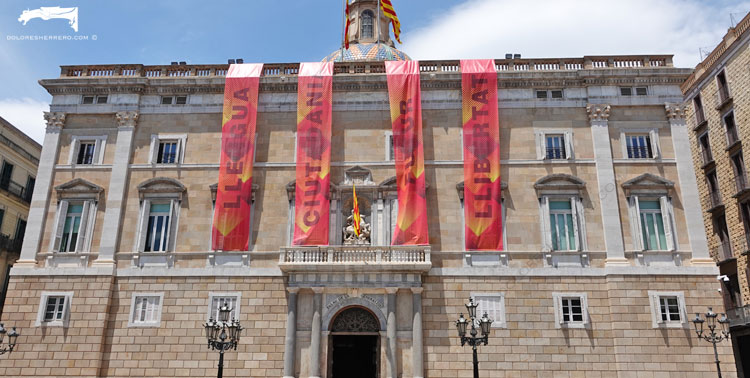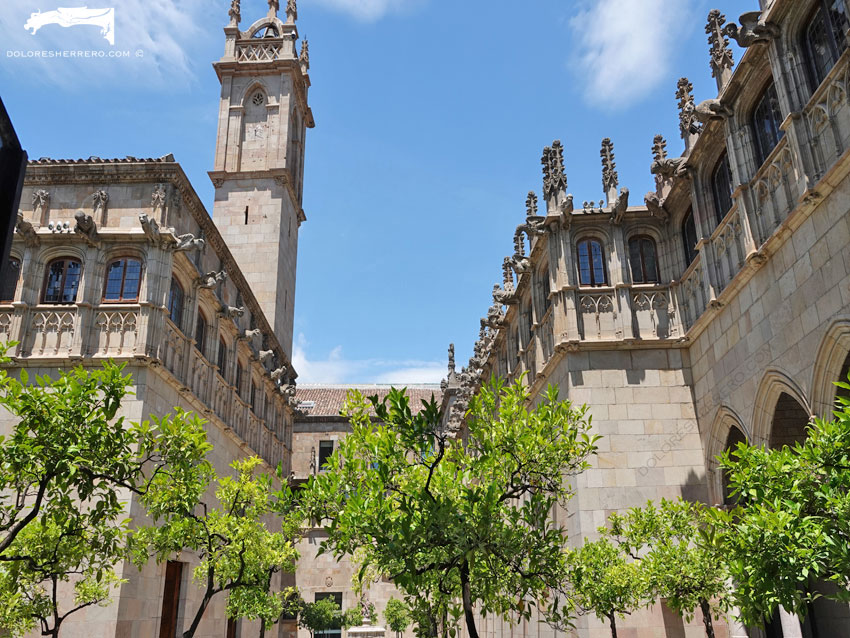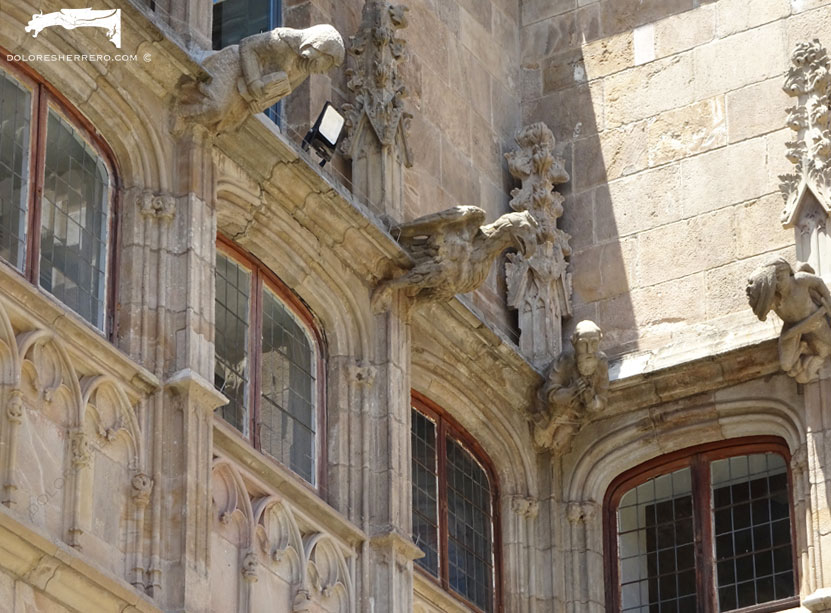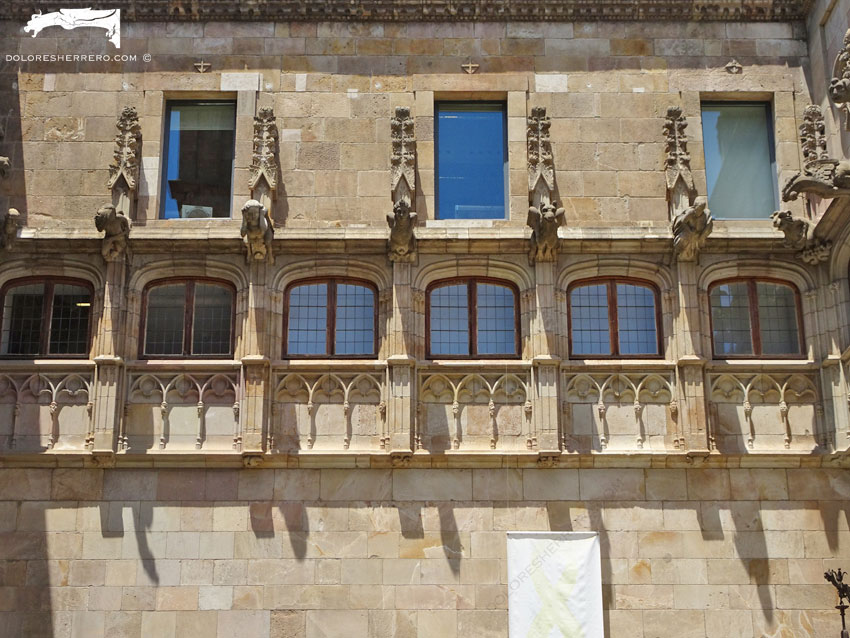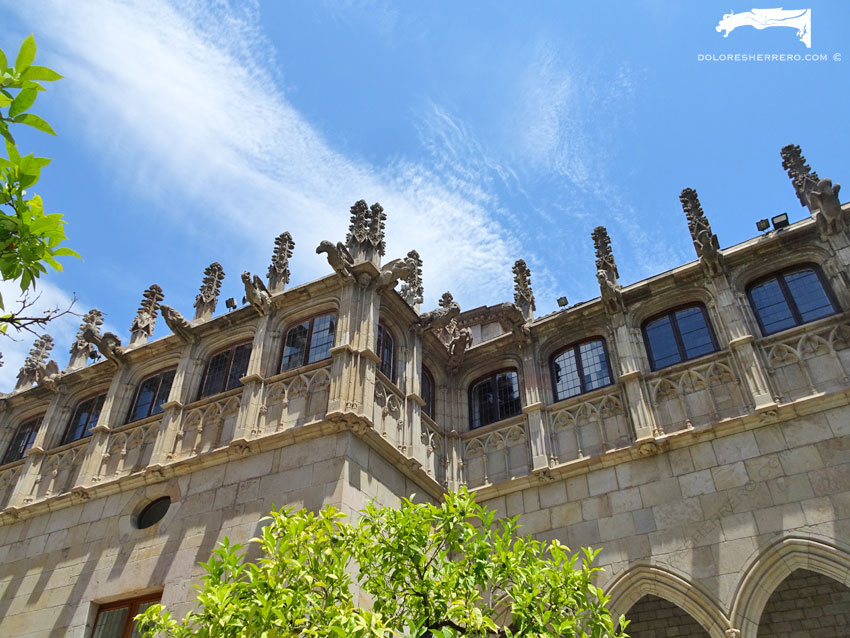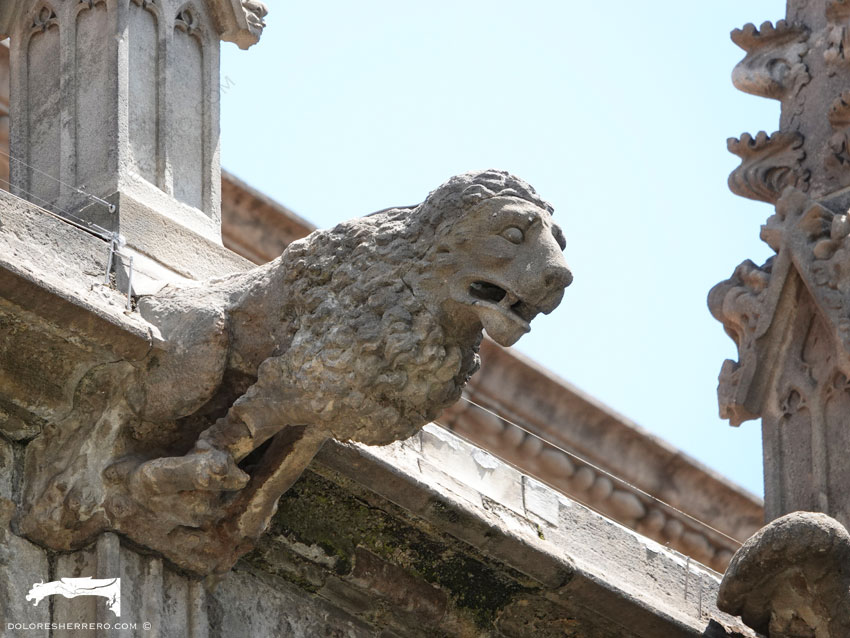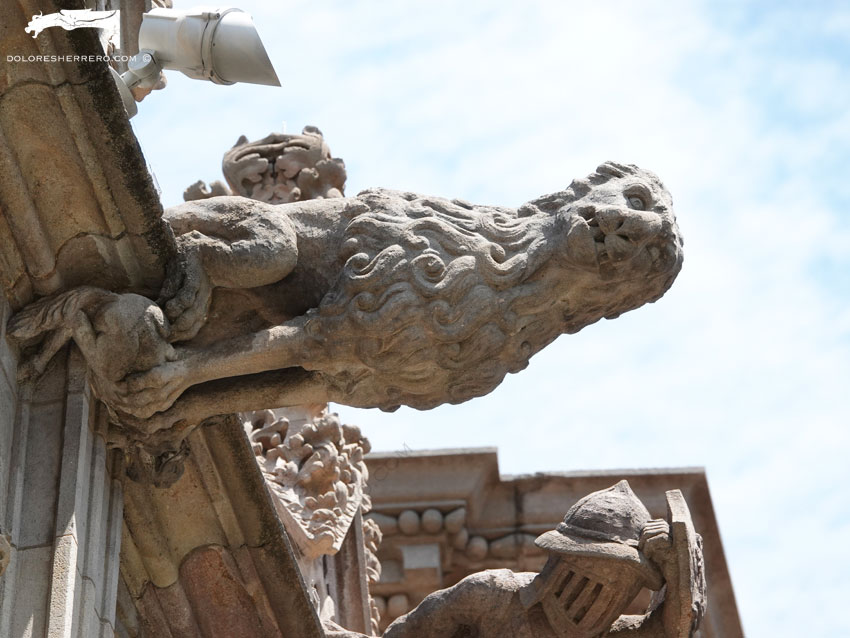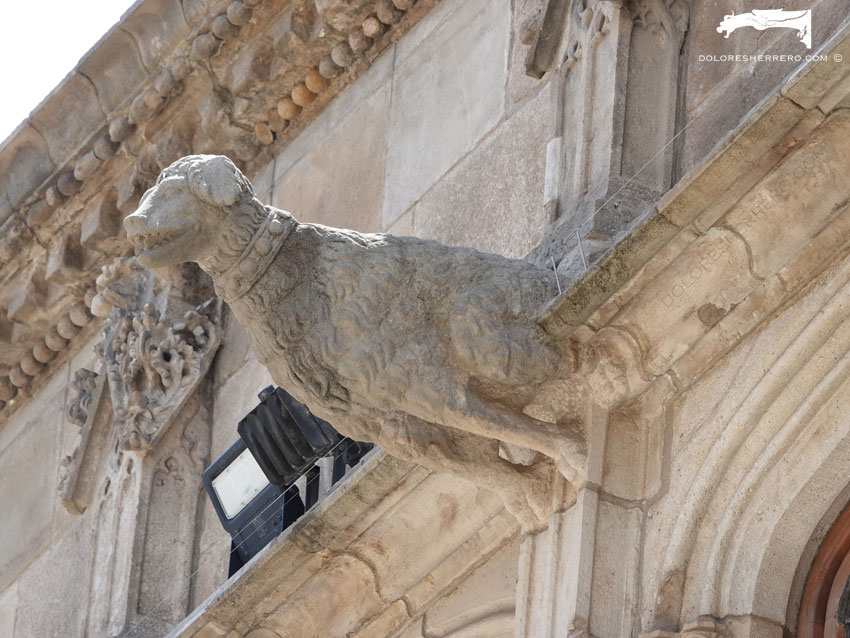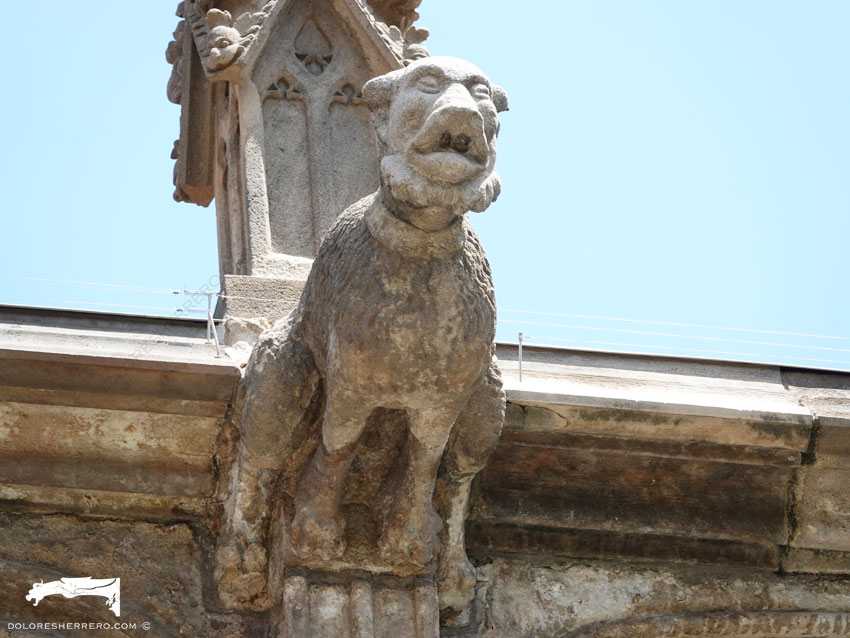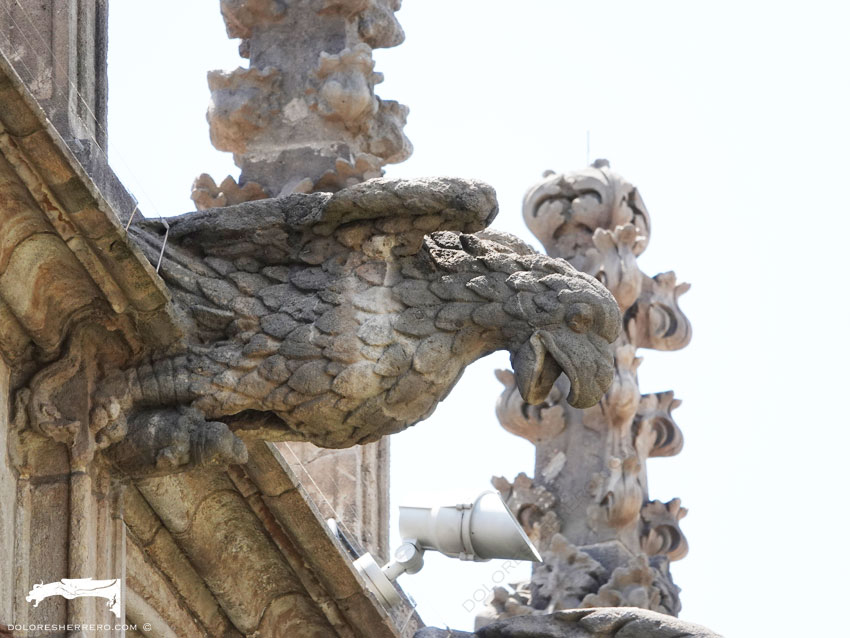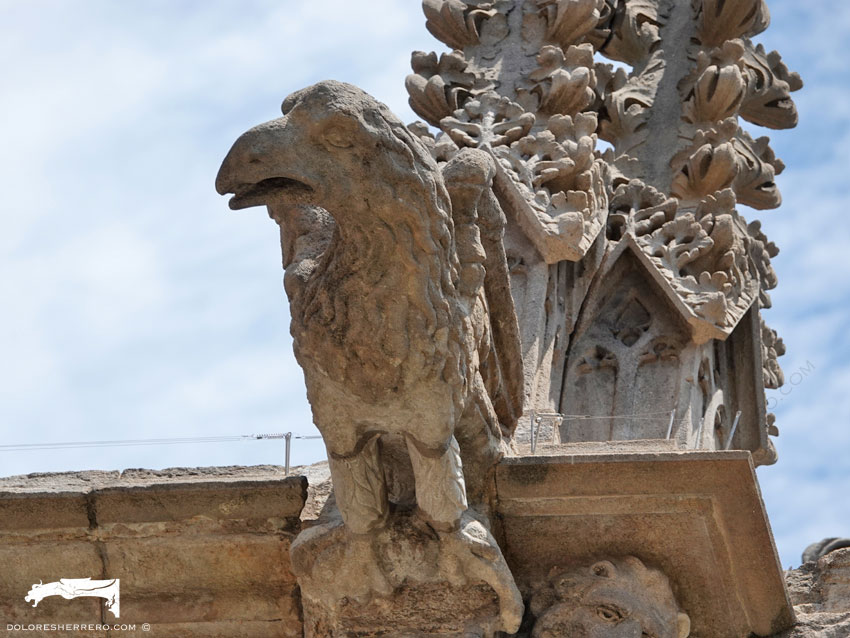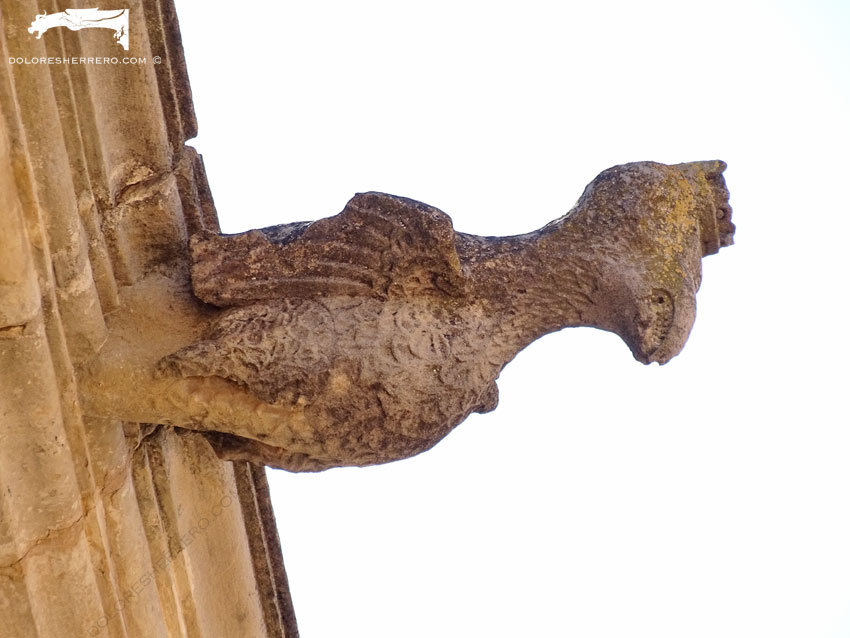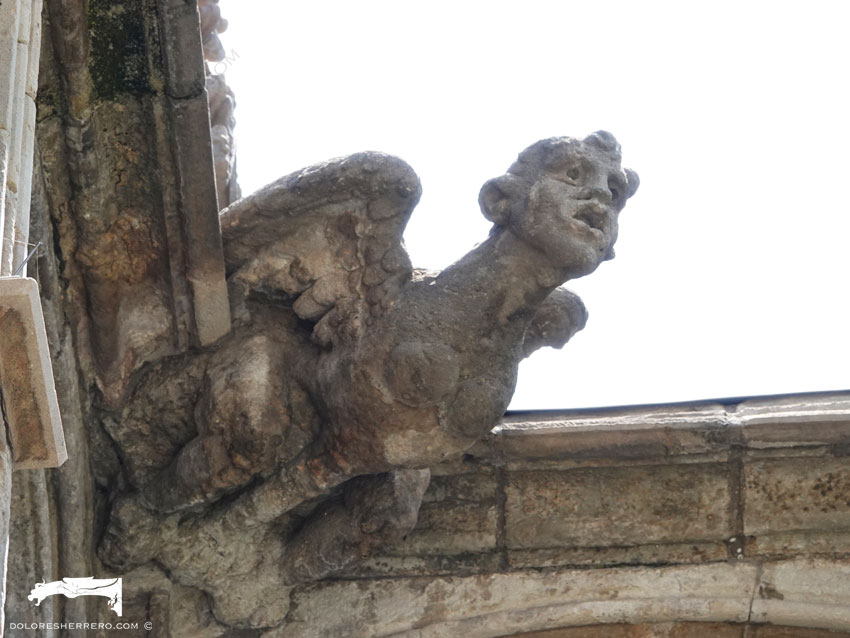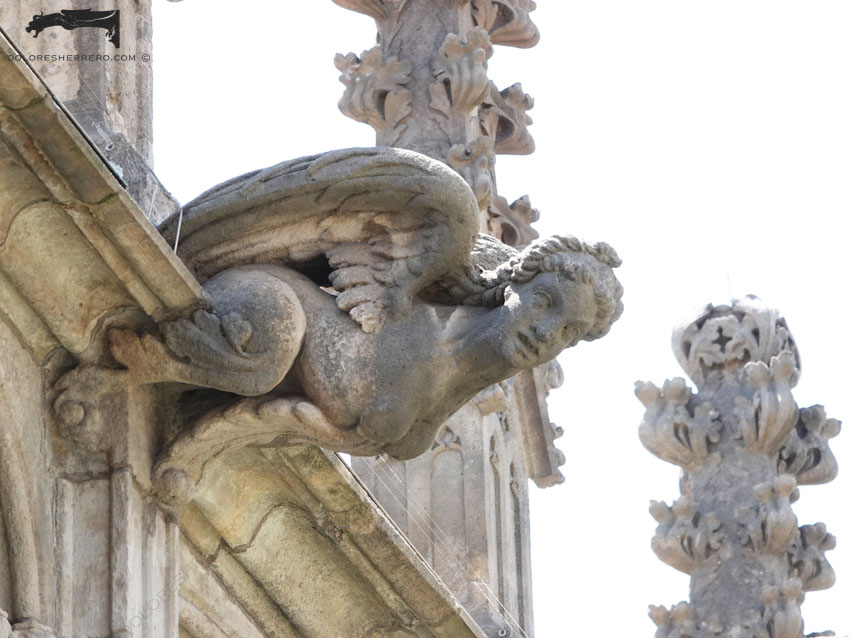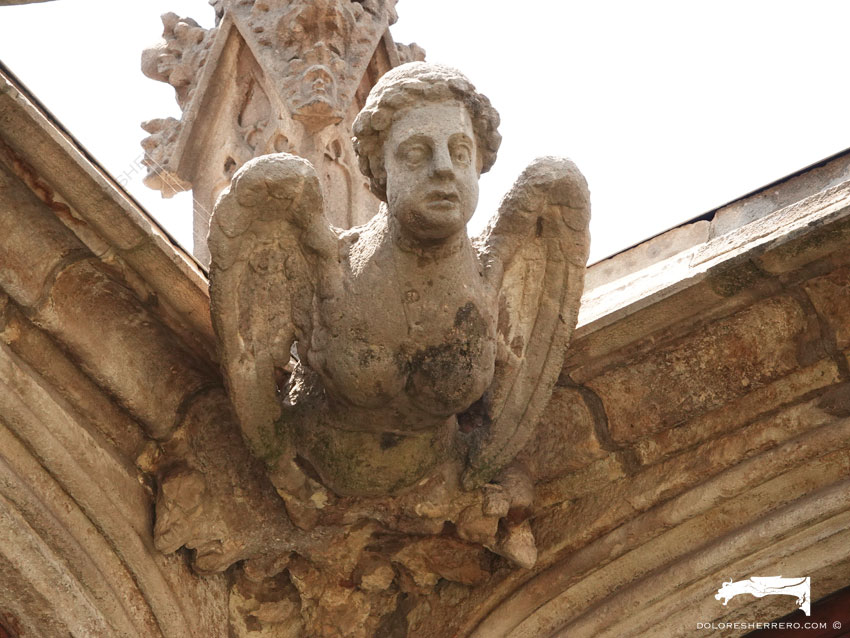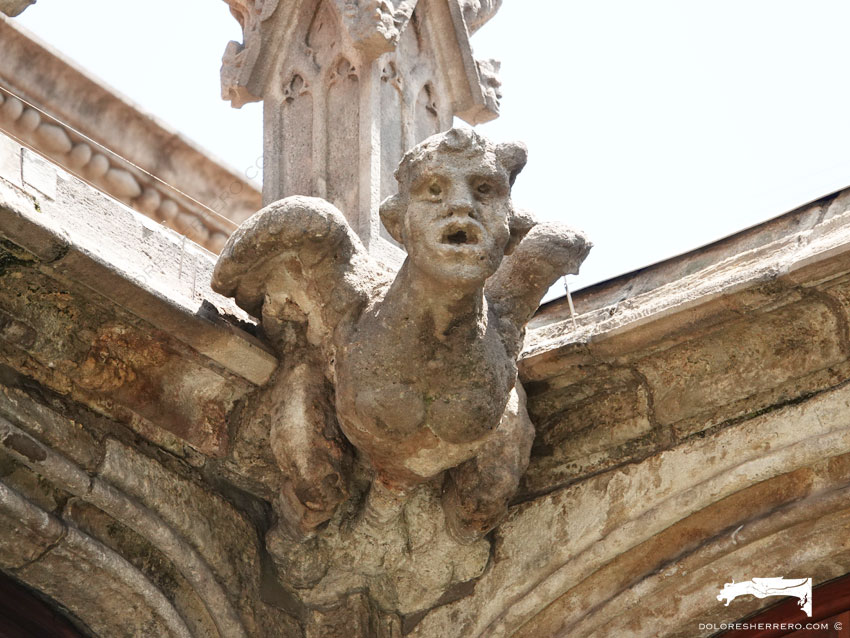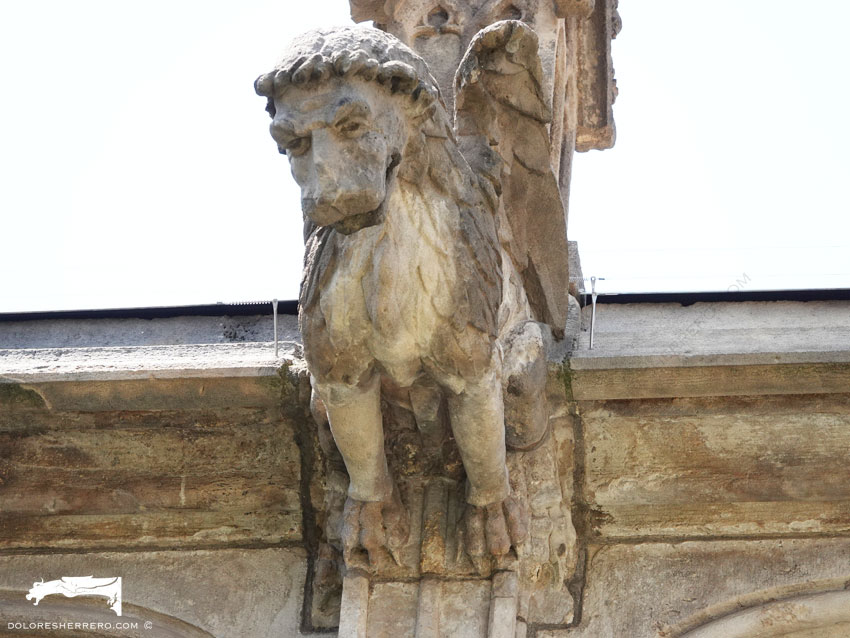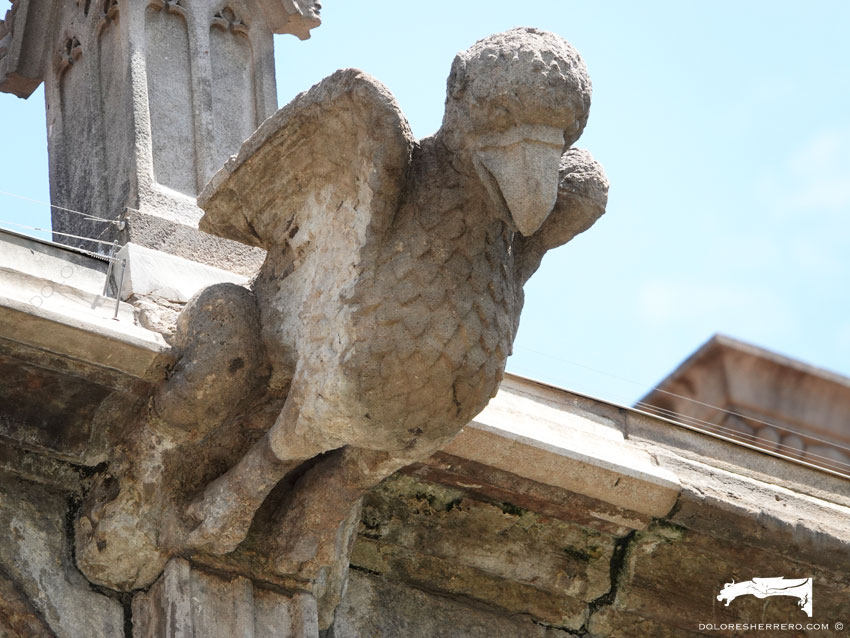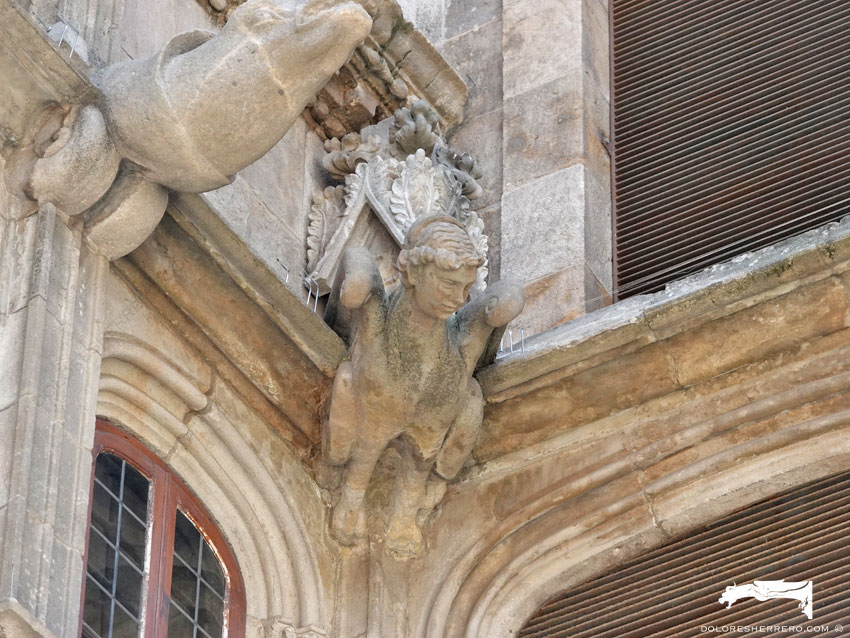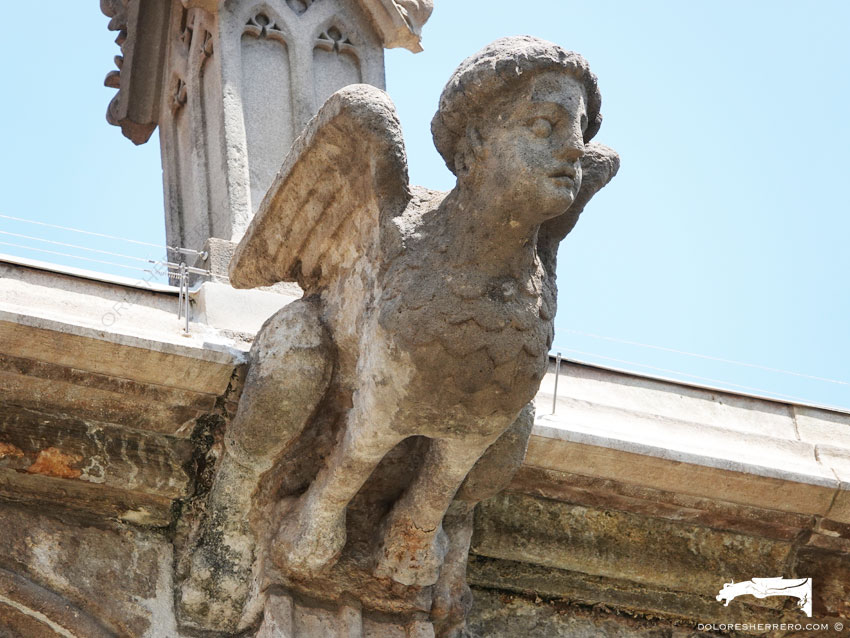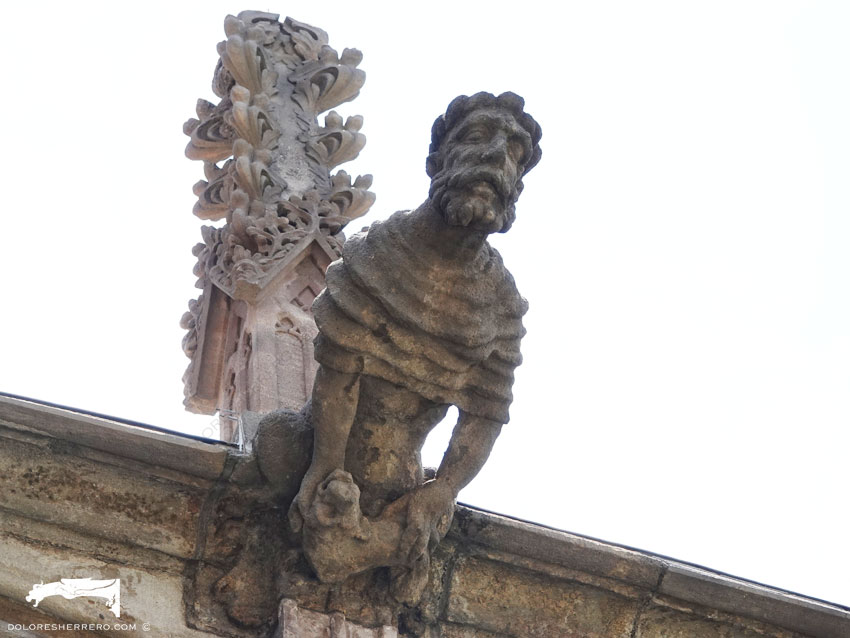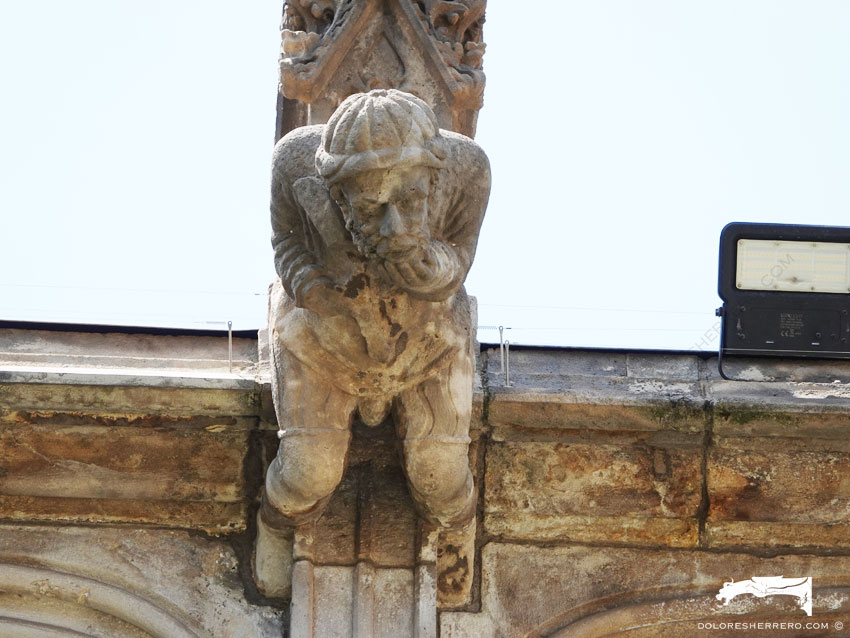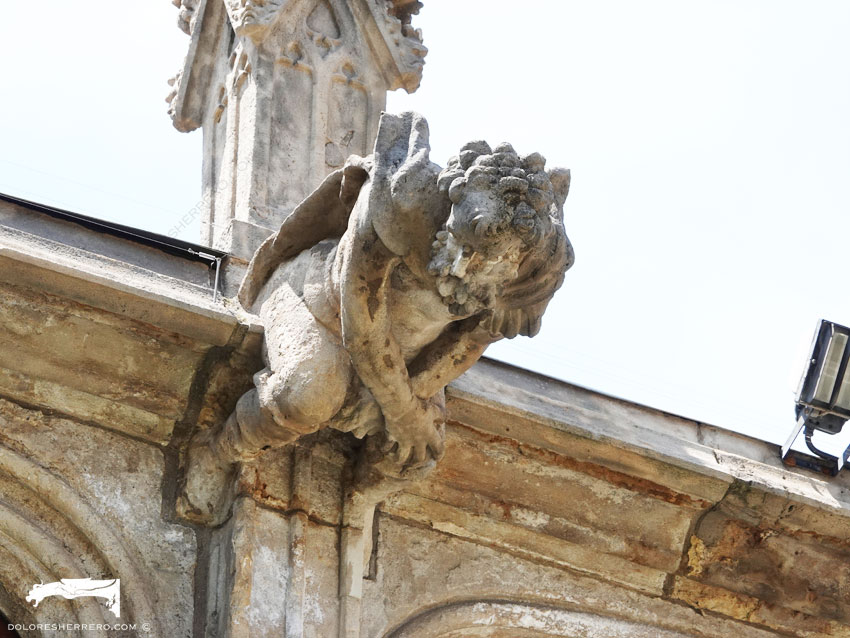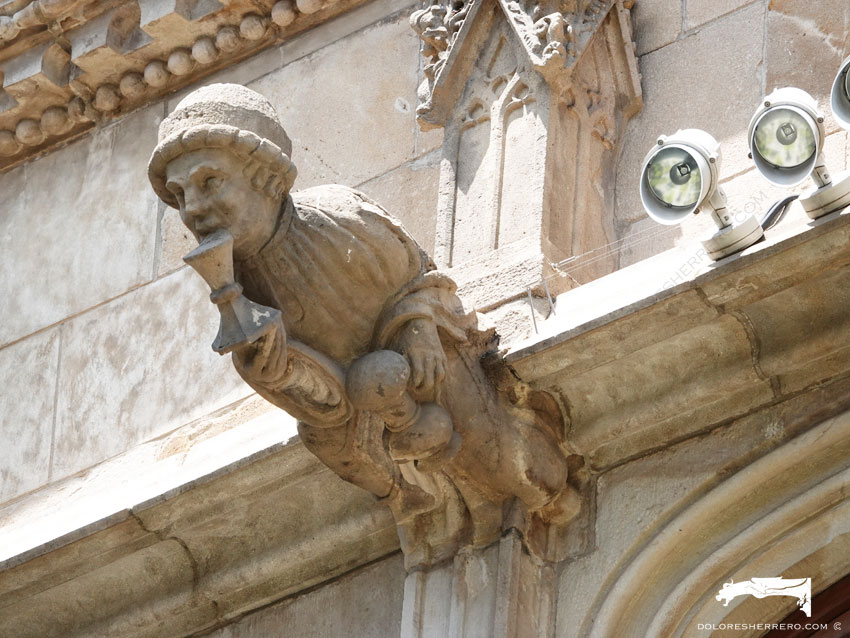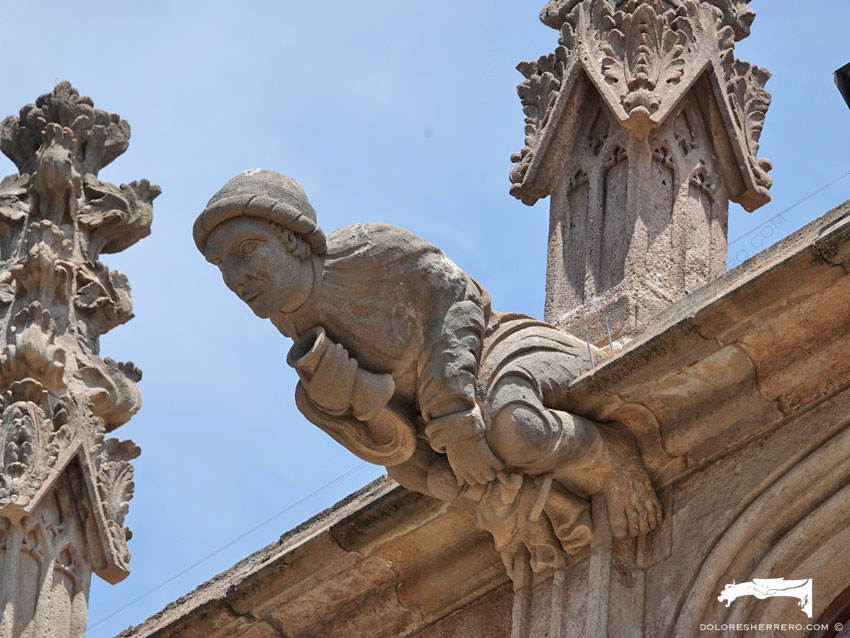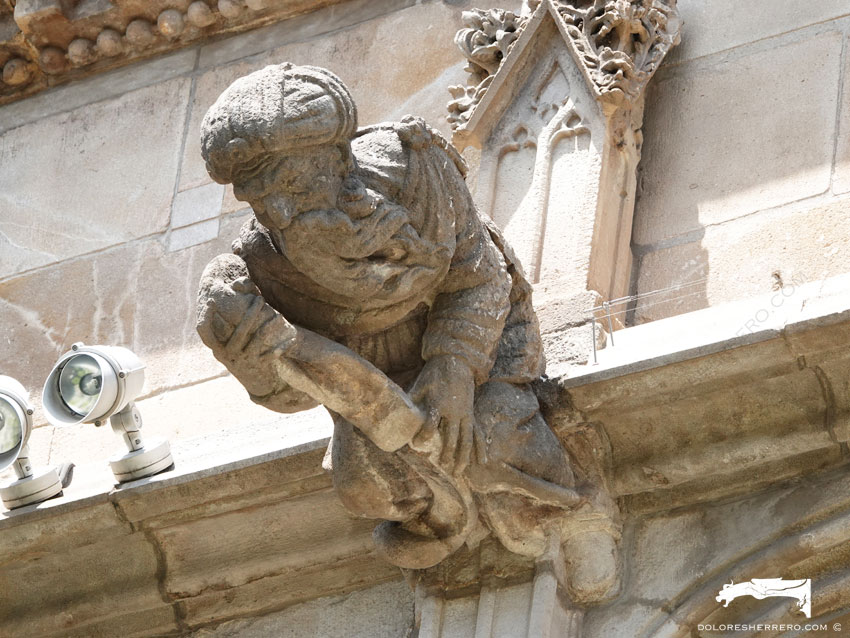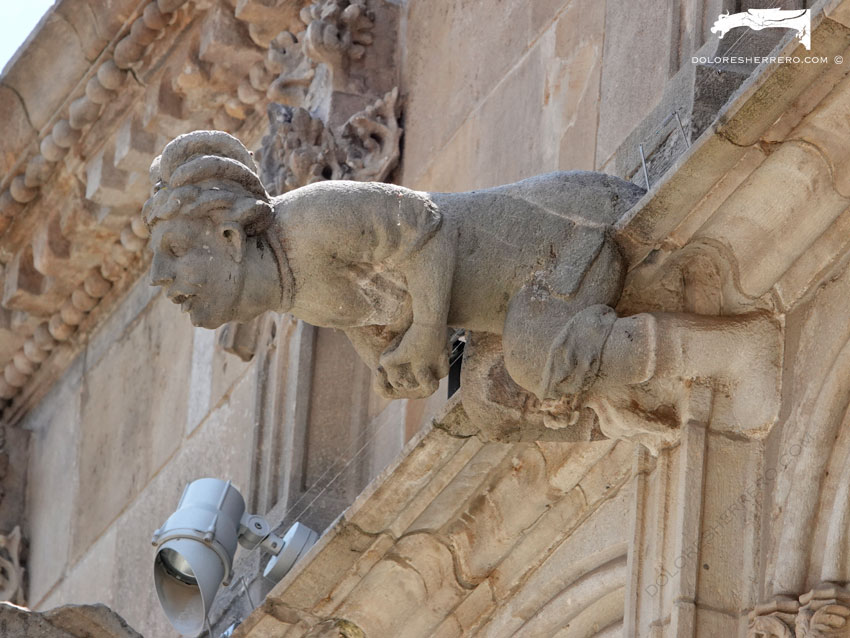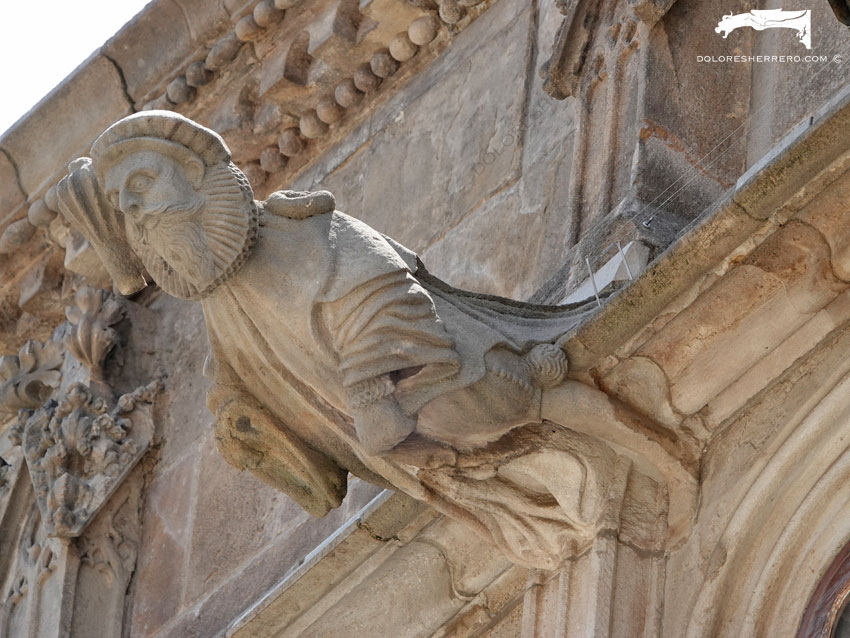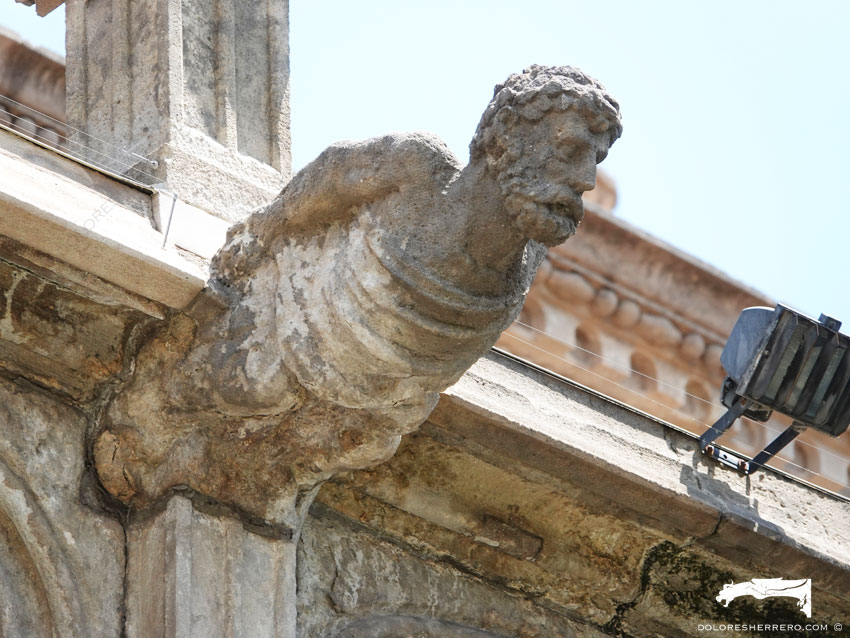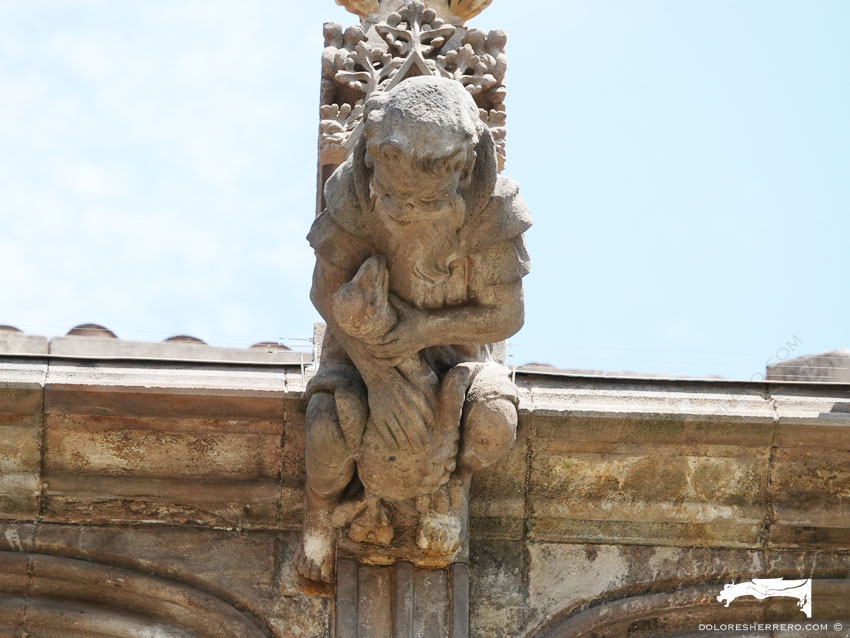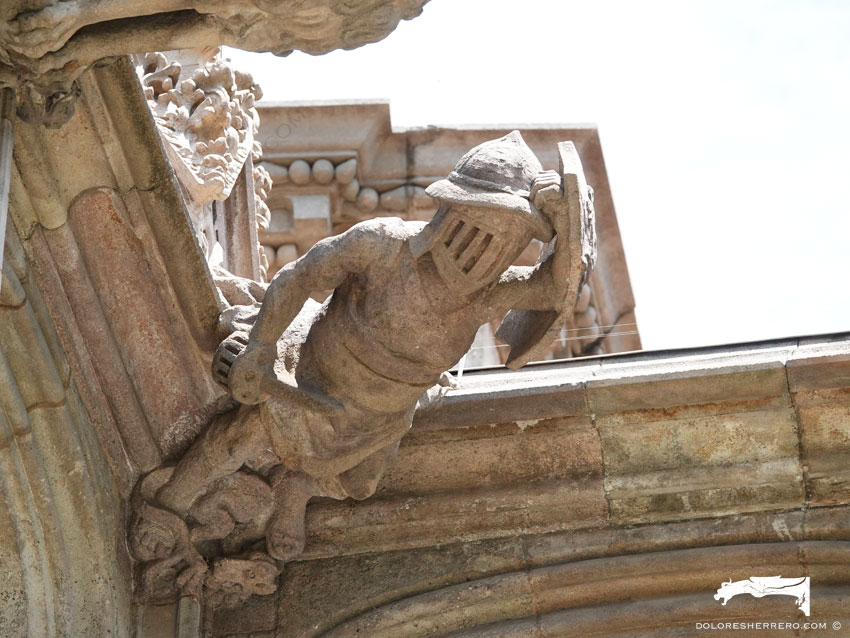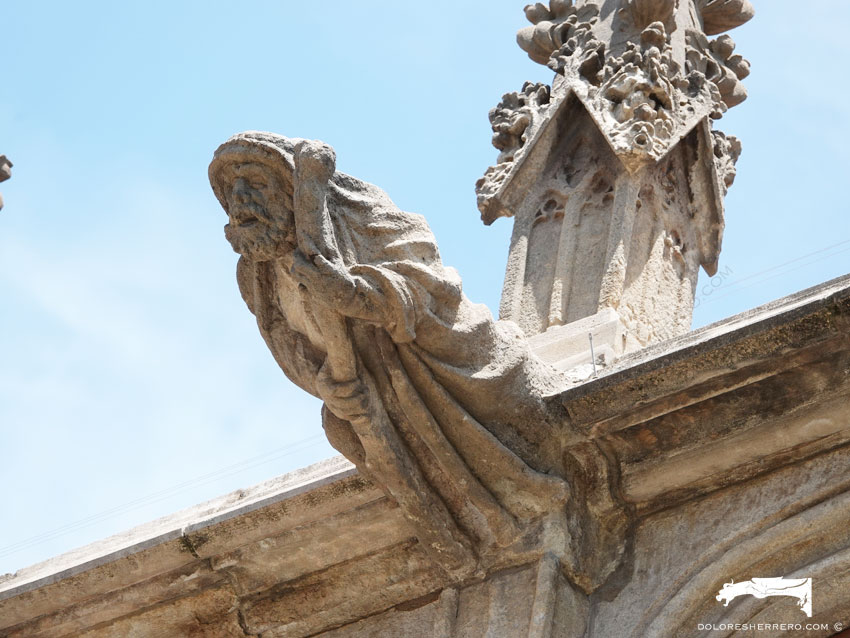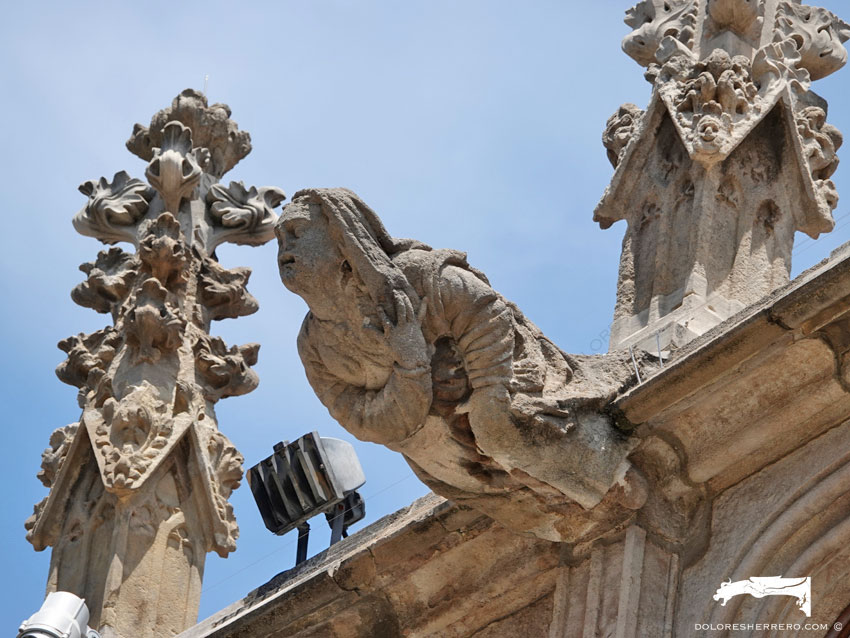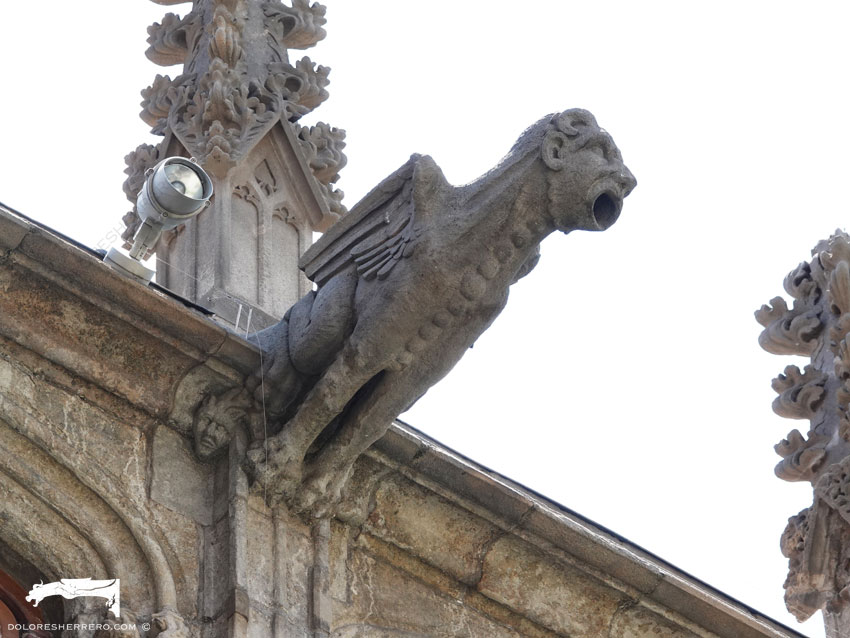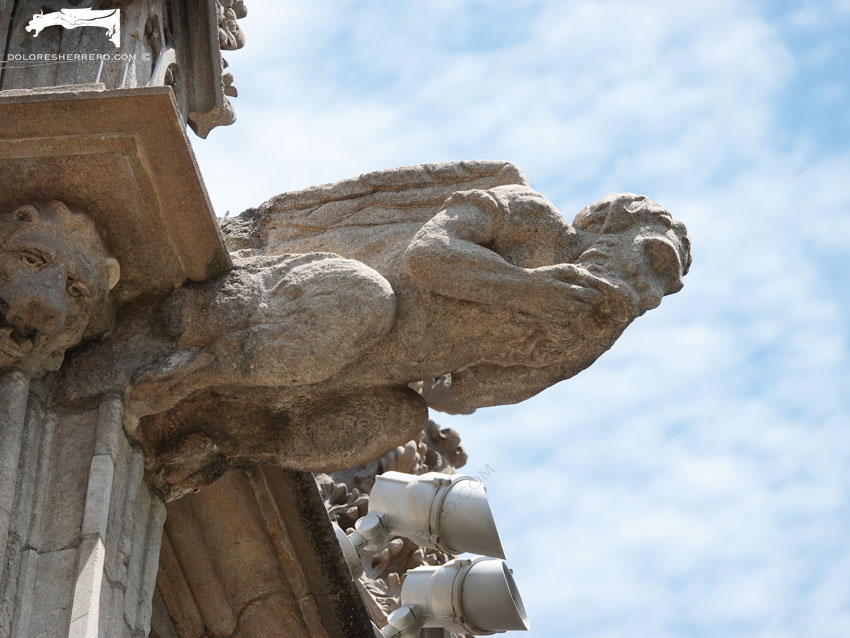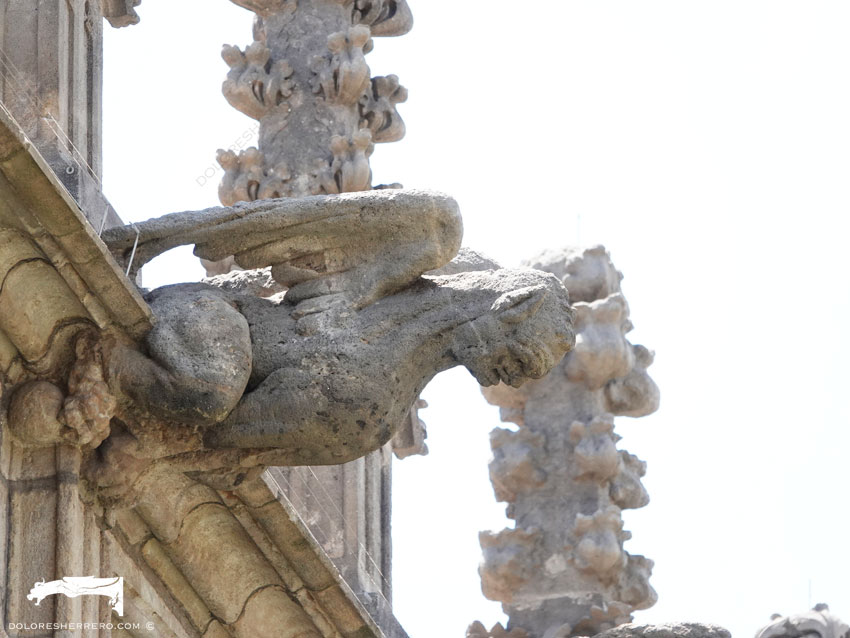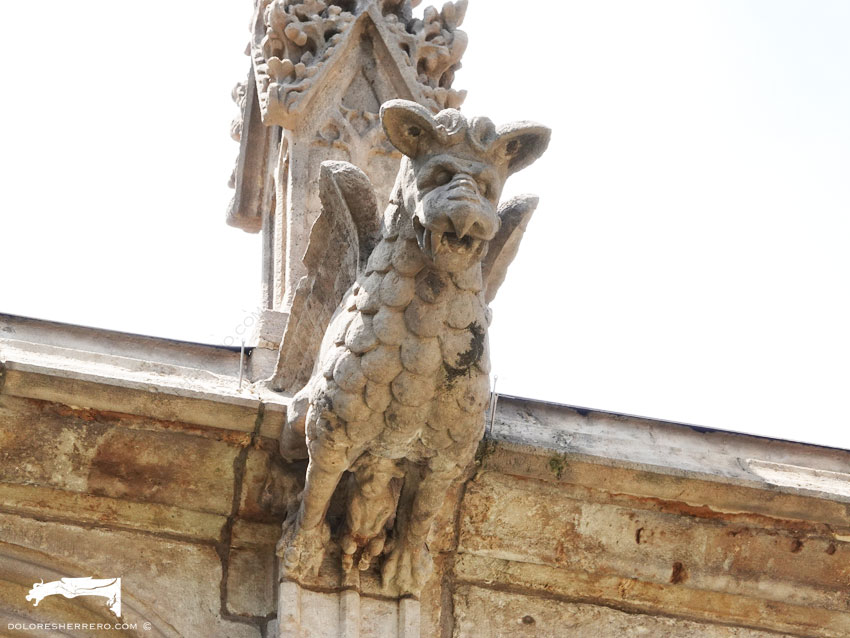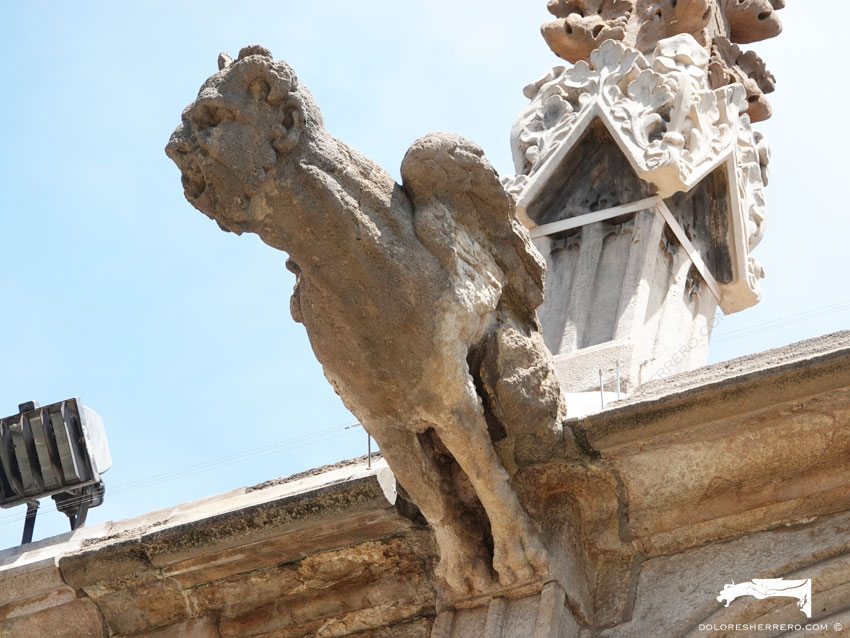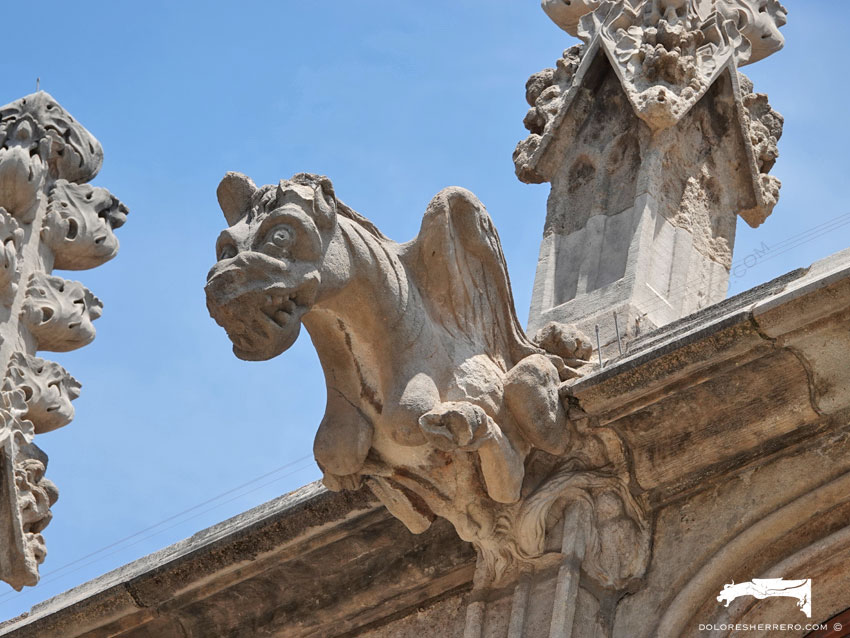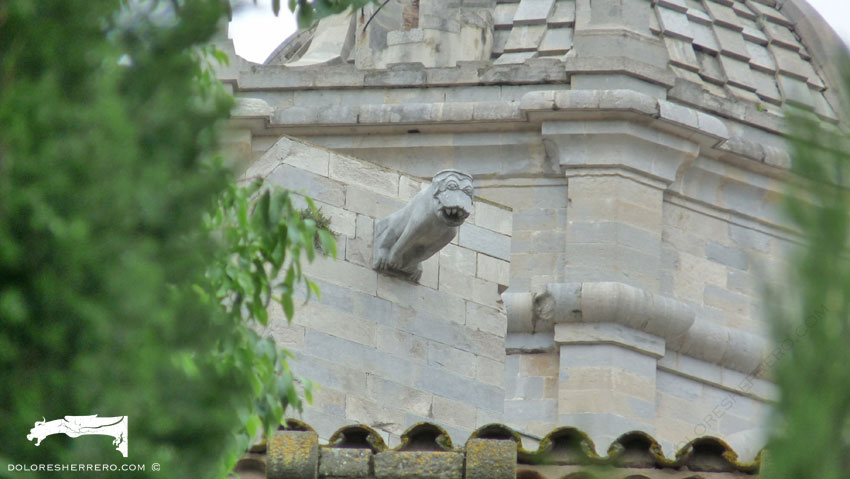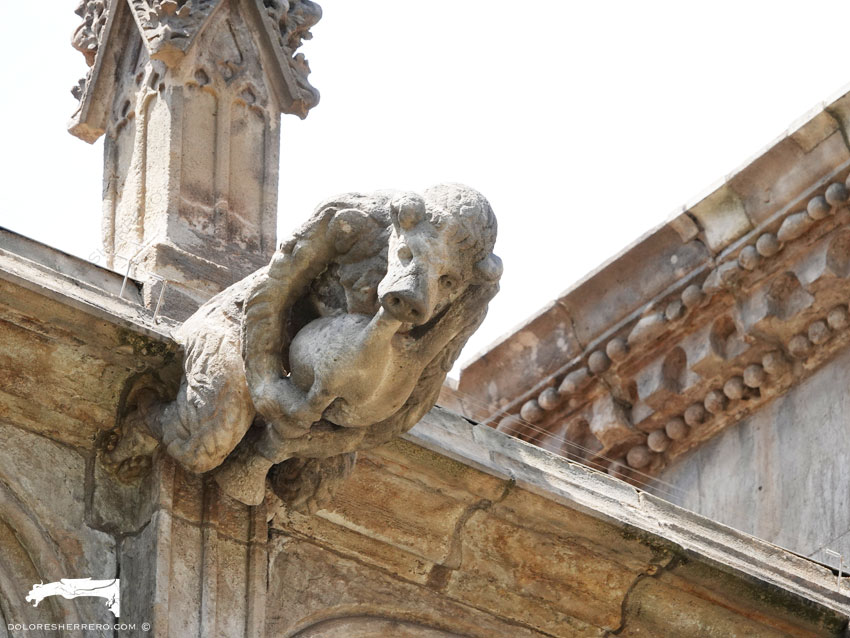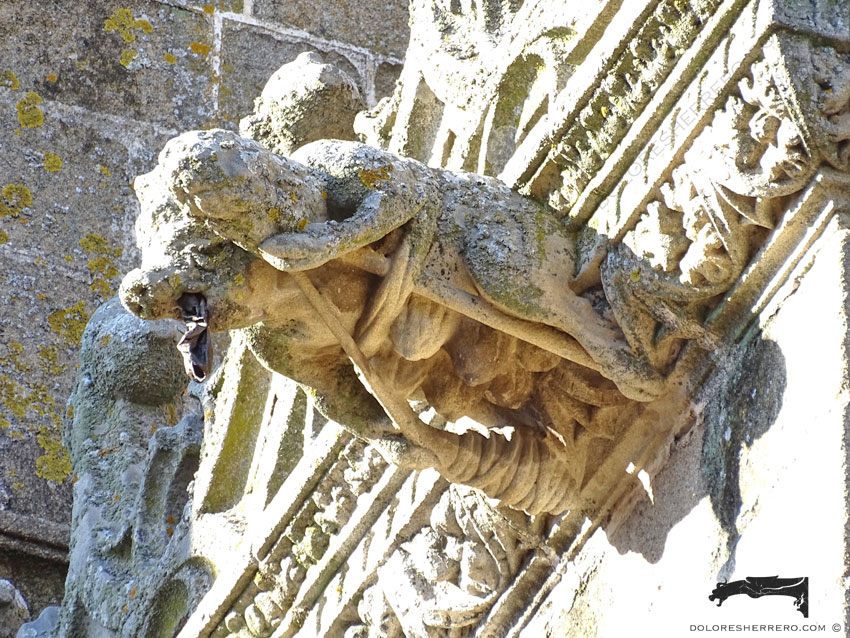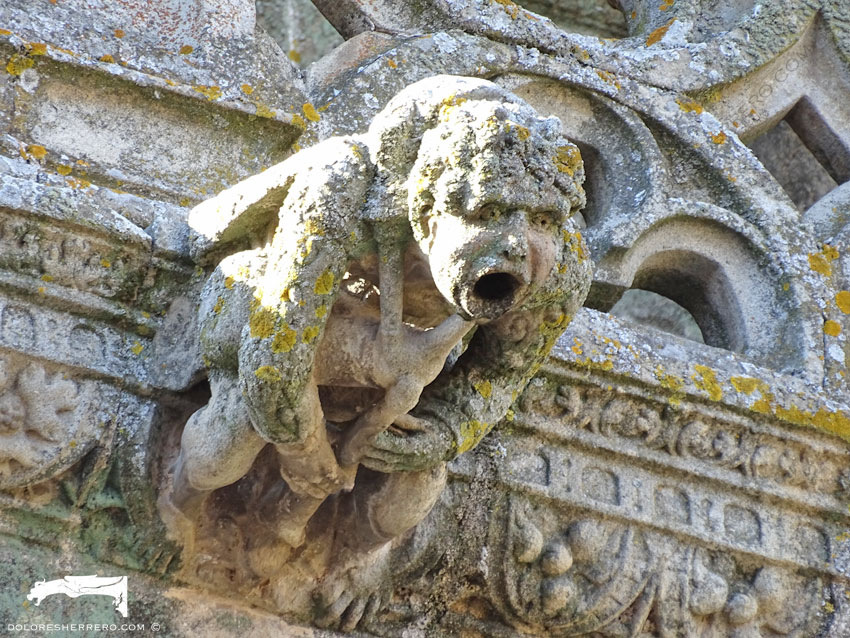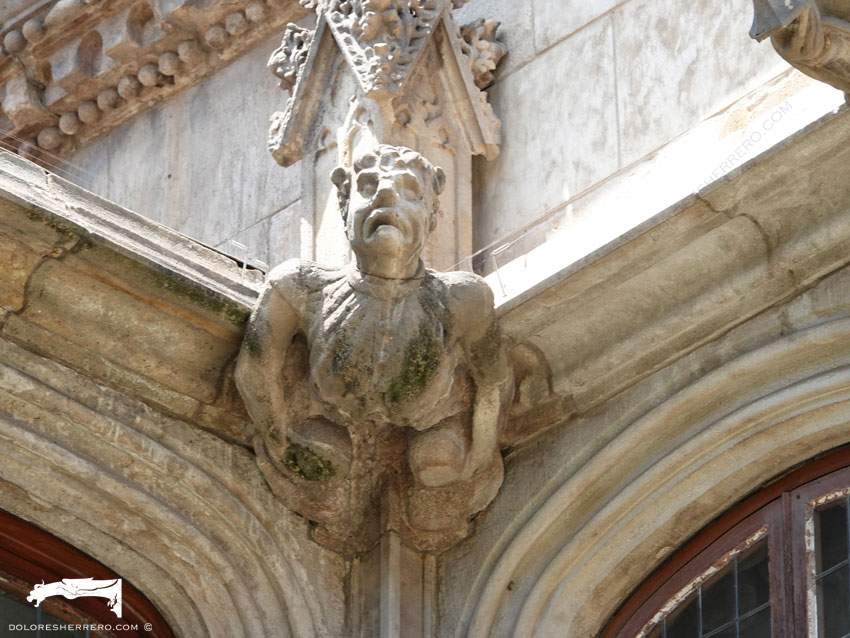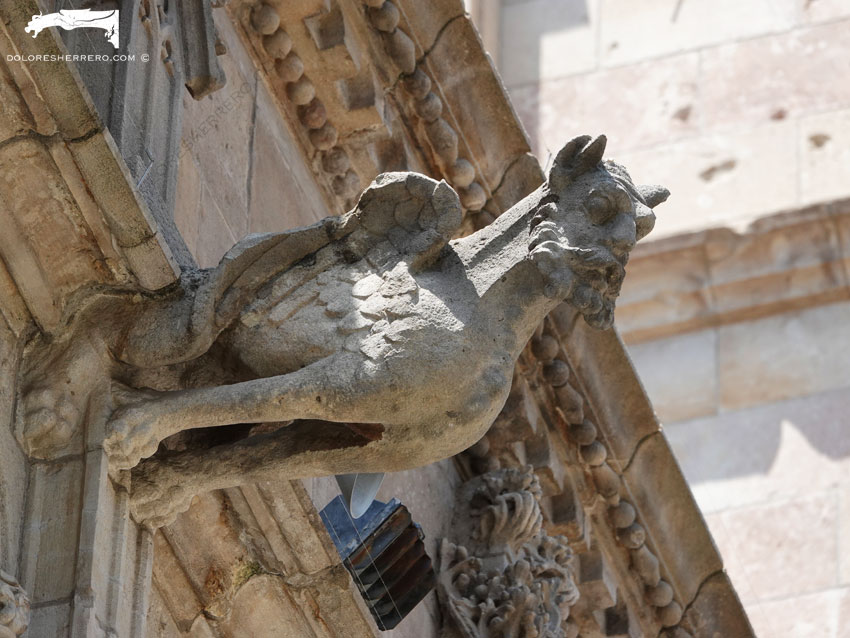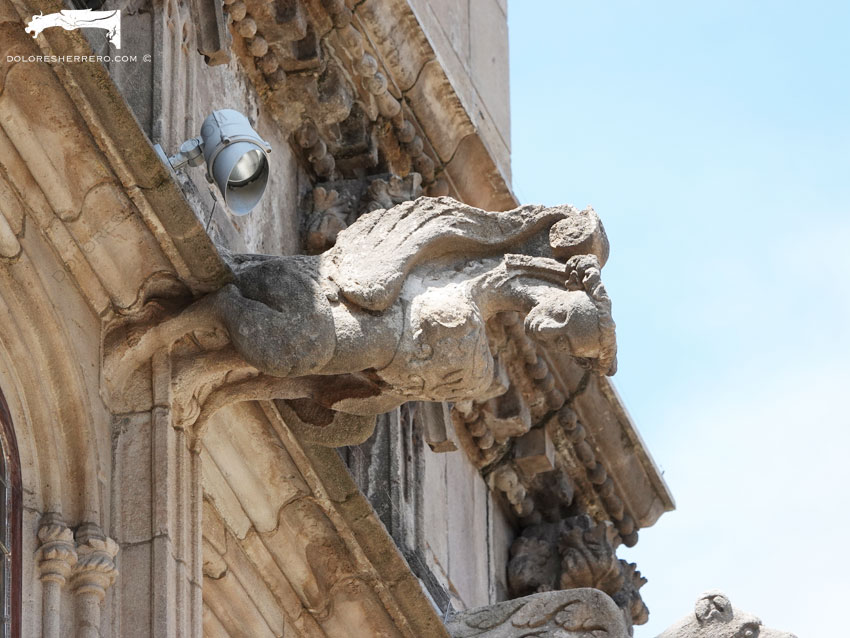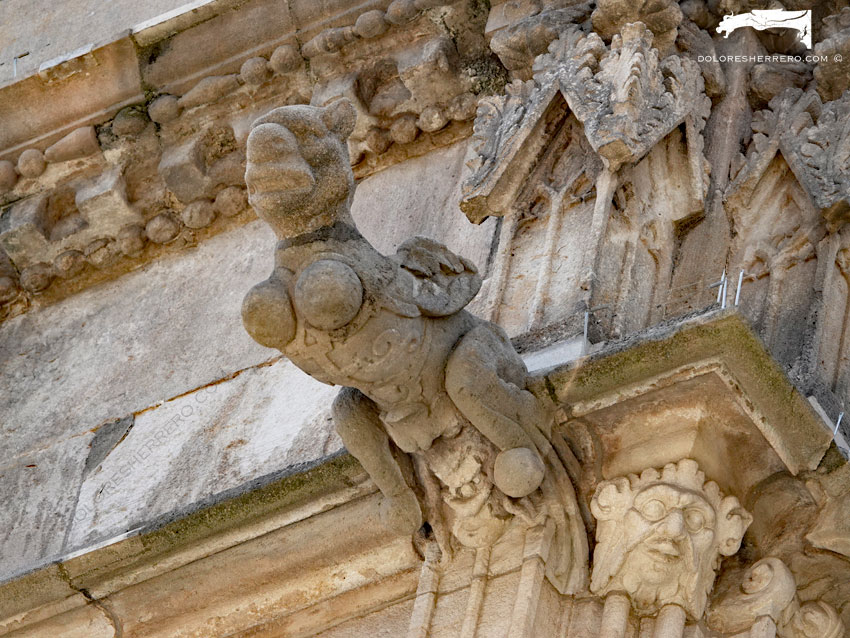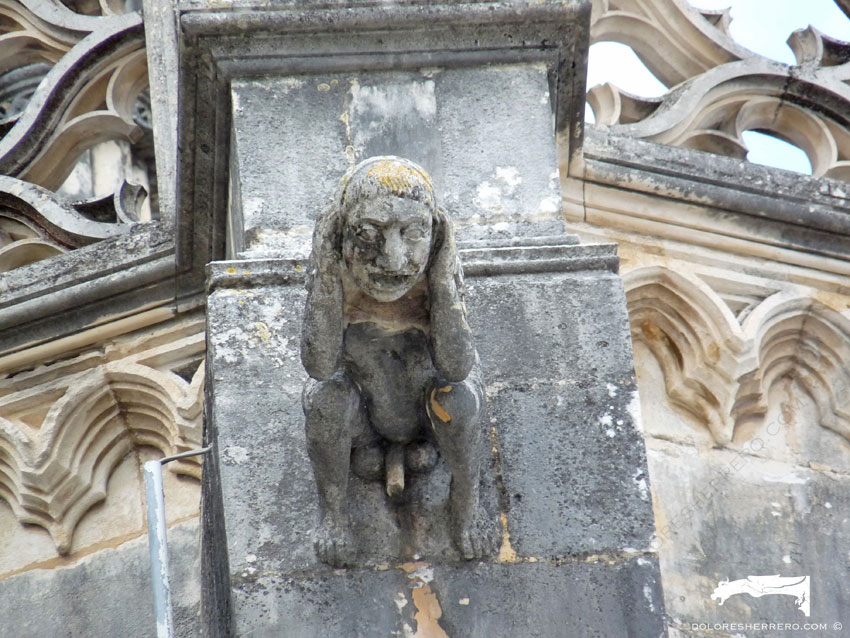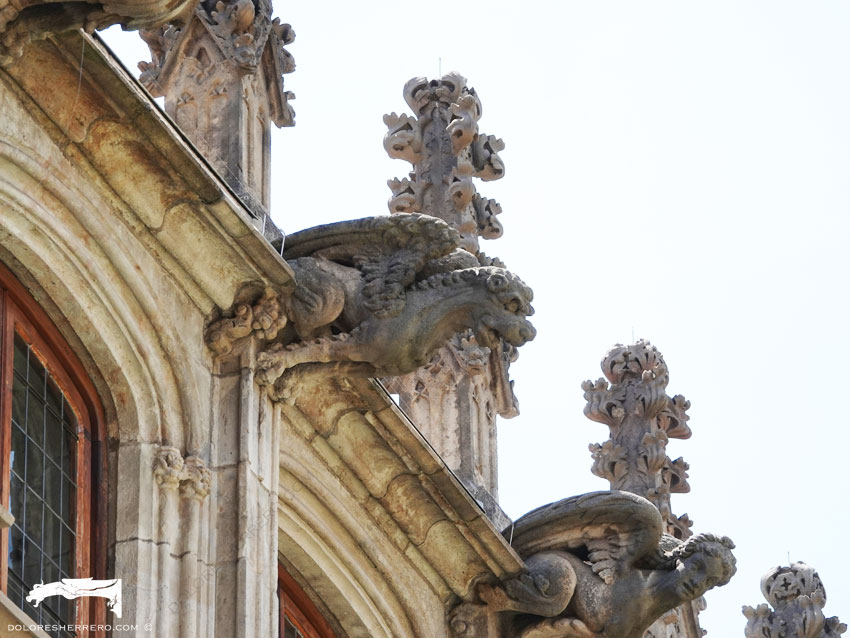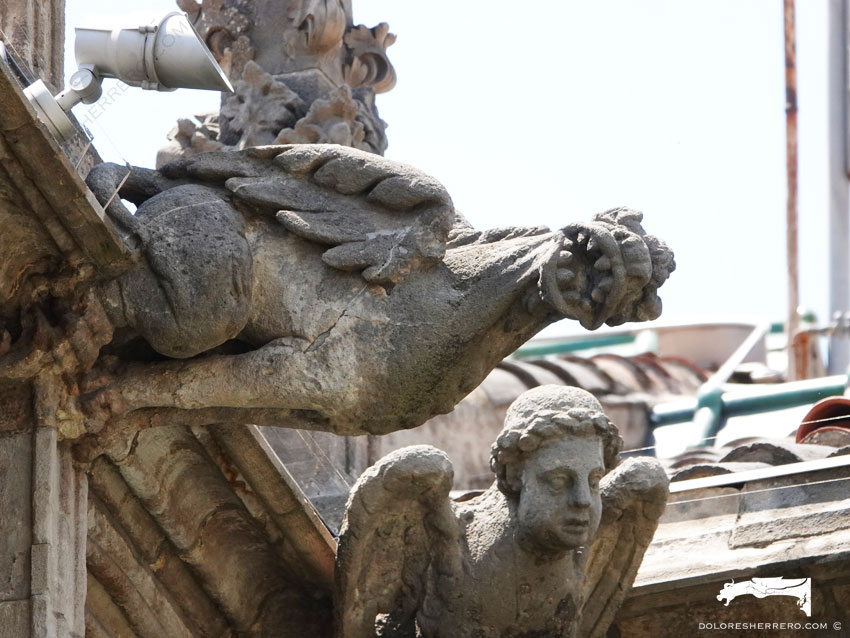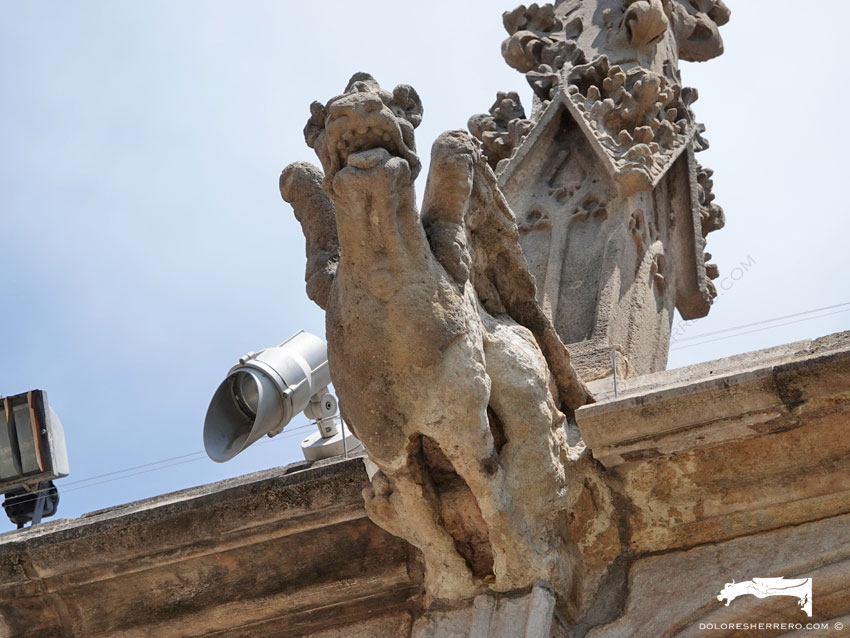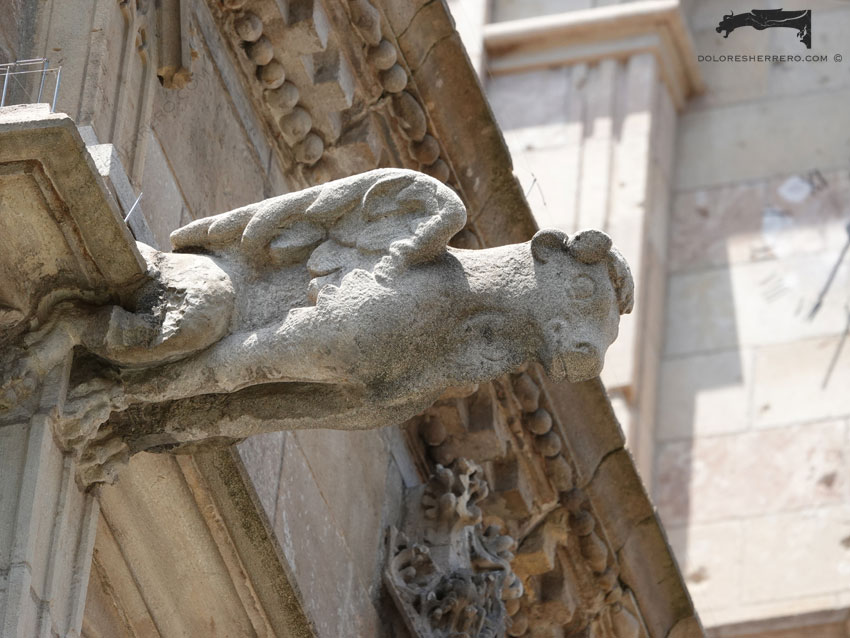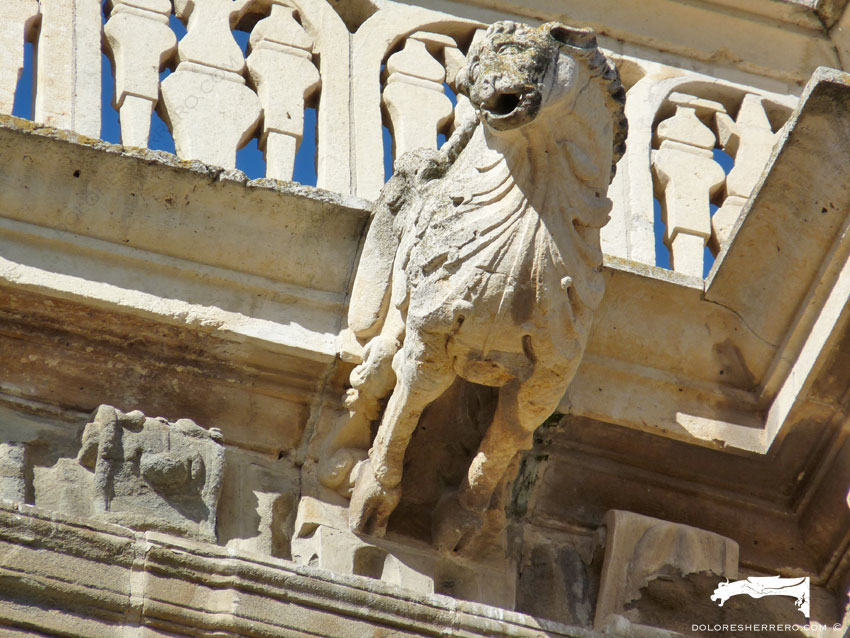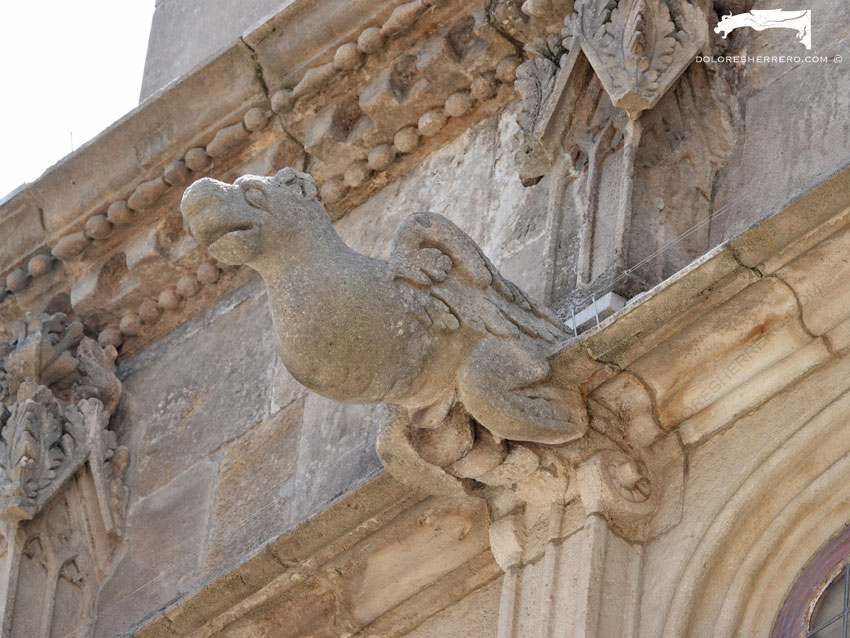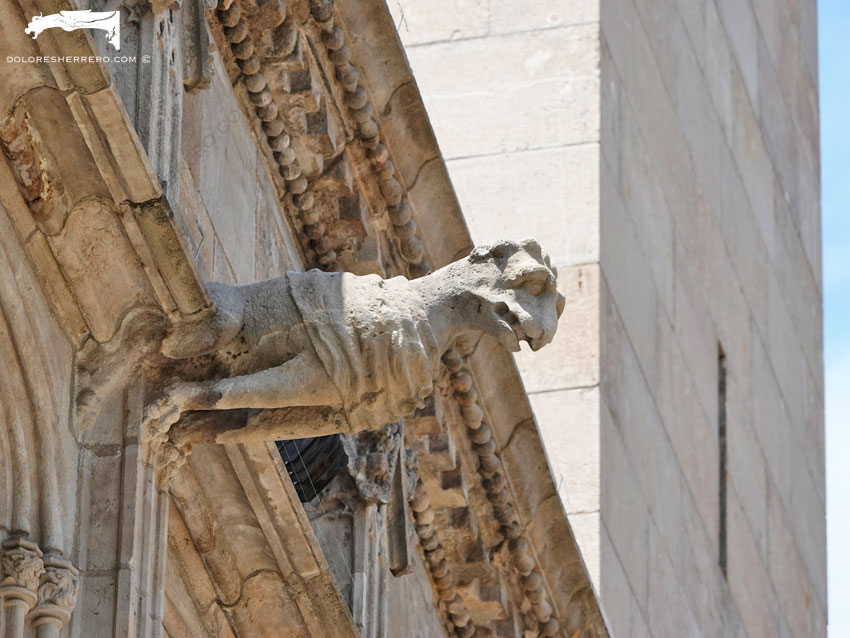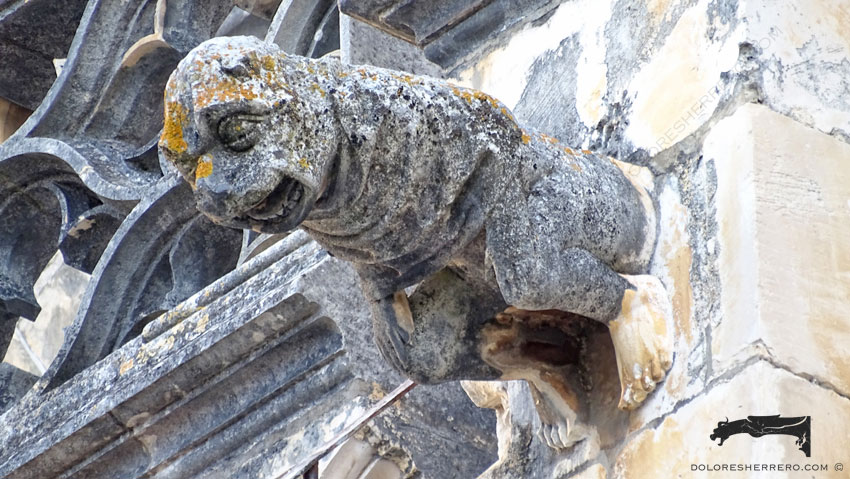The Palau de la Generalitat in Barcelona is the seat of the Presidency and the Regional Government of Catalonia (Spain).
The palace is located in the city’s Gothic Quarter. It was enlarged in the 15th Century and became a magnificent and beautiful building. The palace’s history is very interesting and worth knowing. However, as our study is about gargoyles, we will focus exclusively on them. In this article, you will discover the impressive and extraordinary figures that surround one of the most sensational areas of the palace: the 16th-Century Pati dels Tarongers (Patio de los Naranjos).
As you can see in the title of the article, we have not referred to them simply as ‘gargoyles’, but as ‘gárgolas quimeras’ [chimera gargoyles], since the vast majority, if not all, apparently do not have a gutter, spout or mouth through which the water flows. We could have written an article about the chimeras or grotesques of the palace; however, we have incorporated the word ‘gargoyle’ because of the shape and theme typical of the Gothic gargoyles we all know.
Stone hybrids and their classification: Typologies of the ‘chimera gargoyles’ of the Palau
All of them are worthy of an exhaustive study that would require a thesis, as they are full of enigmatic, striking and unique details, as well as symbolism related to the building, the sculptors and the history of the palace and, surely, of the city itself. As there are many and we want to show you all of them, we will look at them by typology of figure to make it easier and more organised. As always, many figures are difficult to categorise because they can belong to more than one typology; however, we will include them in one or the other according to whether they have very clear or characteristic features or characteristics of a specific type. We hope you enjoy this tour. We are going to start with the typology of real animals, which is so-called to differentiate them from fantastic or mythological animals.
Real animal
Within this typology are the three animals most commonly represented in gargoyles: the lion, the dog and the eagle.
Lion
Lions are magnificent with diverse characteristics: with a cub, rampant and holding a shield, or one with its head tilted (dynamism) grasping a small creature of evil appearance, a possible struggle between good and evil. The carving is magnificent in its detail: manes in the form of locks of hair, pointed claws, fangs, and pupils.
Dog
The figures of dogs, the faithful guardians, have characteristic elements such as the collar that is often seen. One has flat, drooping ears and the other has half-closed eyes; both have fur (one also has a beard-like collar).
Eagle
The eagles are very interesting: two of them are grasping an object or small undefined creatures, again making a possible reference to good conquering evil; another has plant decoration on its body (a large leaf), a flower below, talons ending in a leaf-shaped grotesque form and a gaze directed upwards—a pose that makes it a figure of great originality; and the last one is wearing a crown, an element reminiscent of one of the gargoyles on the Town Hall of Torre del Compte in Teruel (Spain).
- Town Hall of Torre del Compte (Teruel, Spain)
Fantastic or mythological animal
In this typology, we discover amazing figures. Various mythological beings are represented: harpies, gryphons, dragons and sphinxes.
Harpy
There are four fabulous harpies: one with breasts and hollow eyes, treading on a lump or small, undefined creature; another with leaf-shaped legs, plaited hair and breasts, of great beauty and elegance, with truly exuberant wings; and two more with breasts and plaited hair.
Gryphon
The gryphons are very original. The first has a mane in the form of acanthus leaves, a beautiful plant-like touch; another has the face of a lion, but we have not included it as a winged lion because it has feathers instead of a mane, and with pupils that give expression to its face; another two have the head of a bird; while the last holds a shield or parchment, with one paw raised and the other supporting the shield, also a truly magnificent gargoyle.
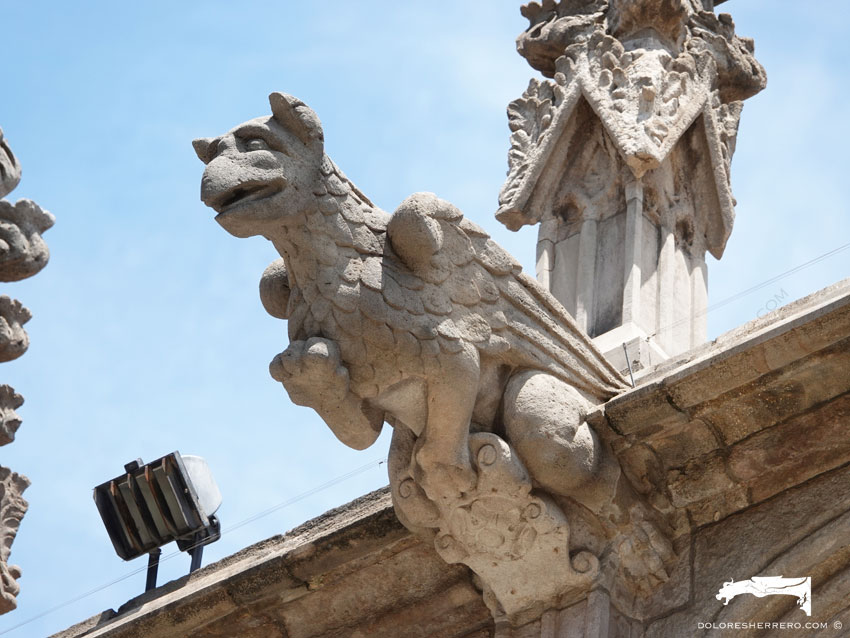
Dragon
This dragon figure is worn, but it is imposing. It is in a rampant position, holding a large shield or parchment with its webbed front limbs. You can see some scales, part of the wings, and the protruding tail.
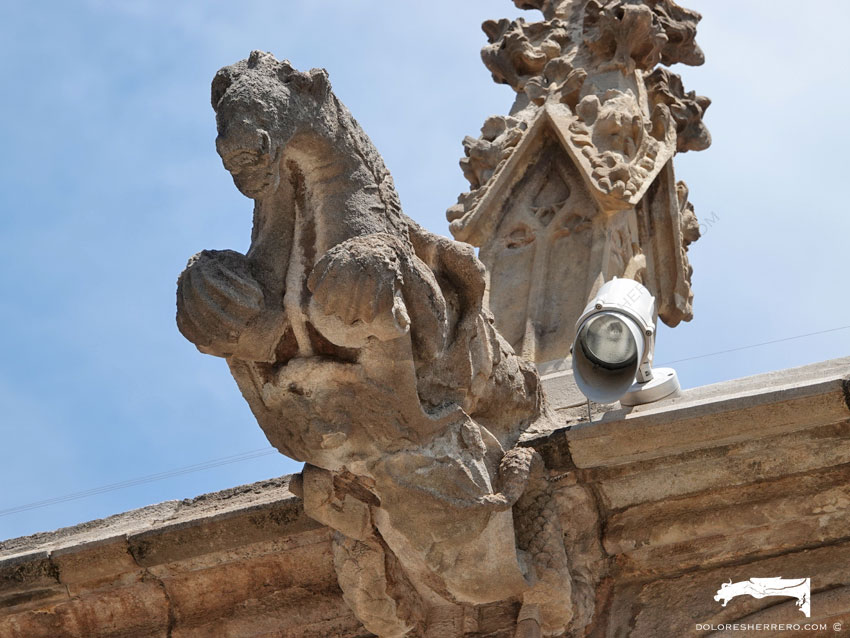
Sphinx
Finally, there are two beautiful sphinxes with fine and elegant features.
Human
We start with a bearded man in short (medieval) clothing holding a small horned creature (maleficent); this could again signify the struggle between good and evil (Fig. 1). Another is seated, clutching an elongated object (unrecognisable), with an expressive gesture and dynamic position, and with braided hair on his forehead (Fig. 2). The next one is dressed in shorts, boots and a cap, with his left hand on his chin (his right hand is broken) (Fig. 3). Another bearded man with a cape blowing in the wind is sitting with his arms crossed on his knees, his head tilted downwards (dynamism) (Fig. 4). There are also two very similar men, with shirts with the collar turned up and caps; they are seated with their left hands holding a jug and their right hands holding a glass (Figs. 5 and 6). The next man is wearing an Ottoman-style turban, has wrinkles on his forehead, an aquiline nose and a long beard, is seated and is holding what appears to be a snake with both hands, he is a haughty figure (Fig. 7). Another man, wearing a shirt with the collar turned up, trousers below the knee and a cap, is seated with his hands holding an object or small animal, and below him there is a small creature (demon-like) (Fig. 8). We now move on to a man with a long beard, pupils, Ottoman-style clothing, a sceptre and ruff; a figure of distinguished bearing (Fig. 9). Another bearded man wears a cloth that wraps around his torso and has his arms behind his back (Fig. 10). Next is a bearded man, dressed like a monk, apparently with a tonsure and a grotesque face, who is grabbing a bird by the neck; a disturbing figure due to the ambiguity of his intentions, especially in his face and gesture (Fig. 11). Next we see an armed soldier stepping on an animal, possibly a dragon (Fig. 12). Another bearded man in ancient dress from head to toe, with a large stick or stake that he grasps with his hands and who appears to be blind, has the appearance of a biblical man (Fig. 13). Then we see a man throwing himself from its mouth, dressed, with a cap and seated with a vase underneath (Fig. 14). Two soldiers with shields and swords, one with a calm posture and appearance (Fig. 15), and the other covering his head with a shield with a Gorgon-like ornament and his sword and body in an attacking position, giving him a very dynamic appearance (Fig. 16). The next man is trimming his beard (Fig. 17). Finally, there are two female figures: one wearing ancient dress from head to toe, with her right hand on her breast and her left on her knee (Fig. 18); and the other with a friendly expression and similar dress, although this could be more religious, holding a block in her hands (perhaps a book) (Fig. 19).
- Fig. 1
- Fig. 2
- Fig. 3
- Fig. 4
- Fig. 5
- Fig. 6
- Fig. 7
- Fig. 8
- Fig. 9
- Fig. 10
- Fig. 11
- Fig. 12
- Fig. 13
- Fig. 14
- Fig. 15
- Fig. 16
- Fig. 17
- Fig. 18

Fig. 19
Demon
The figures of demons have characteristics that are common and specific to the vast majority of gargoyles and chimeras: anthropomorphic features, the body of a winged quadruped, a pronounced windpipe, horns, pointed ears, animal parts such as plumage or a bird’s beak, and small creatures that accompany the figure. There is also another anthropomorphic demon with an animal-like head, human hands touching the breasts of a woman, a harness, and the hind legs of an eagle that grab and trample two snakes; iconographically it is a very interesting figure. The last two are examples of the gastrocephalus (demons with a second head or face on their stomachs): the first is in a rampant position, has a monstrous-looking head with large fangs and pupils resembling a gargoyle from Girona Cathedral, and with wings, hooves and a woman’s breasts. The second gastrocephalus has flaps of skin hanging from its body, a head with a long snout, large fangs, wings, dog-like ears, fur on its belly and membranous legs that end in a spiral (grotesque); the second head on its belly has long horns and what appears to be a large protruding tongue.
- Girona Cathedral (Spain)

Anthropomorphic
The anthropomorphic figures are striking and highly original. The first has a man’s head and is stroking his beard with his right hand, his left hand is resting on his knee; he has a dragon-like belly, animal-like ears pointing upwards, animal hind legs, and from the waist up he has the body of a man (Fig. 20). The next figure is a pig with a bagpipe (Fig. 21), an image that recalls and embodies two gargoyles from Plasencia Cathedral (pig and bagpiper) (Figs. 22 and 23). Another man, wearing a shirt with the collar turned up, with his hands on his knees and animal ears, makes a very expressive gesture with the corners of his mouth pointing downwards (Fig. 24). There is also a winged quadruped with a human head, beard and ears pointing upwards; an imposing figure (Fig. 25). Next, we see a woman with a beautiful face, with large wings, head tilted downwards, a shield on her chest and the hindquarters of a billy goat (demonic) (Fig. 26). Another has the head of a dog, small wings, hind legs ending in a spiral, which could also have a monstrous head underneath, it is wearing a harness and has the breasts of a woman (Fig. 27); a figure reminiscent of a gargoyle (a bird with breasts) from Batalha Monastery (Portugal) (Fig. 28). The next figure is a bearded man with leaf-like wings wearing a headdress with spirals and a large leaf on his body (Fig. 29). Another figure is a quadruped with cloven hooves (demonic), a human face, large fangs, dog-like ears and a plume (Fig. 30). A woman with a necklace, small wings and reptile-like legs has a flower on her head and a leaf on her stomach (Fig. 31). Another woman with delicate features and hands on her ears (a gesture that again recalls one of the gargoyles at Batalha Monastery) has cloven hooves and a large leaf on her stomach (Figs. 32 and 33). Finally, there is a man with fantastical elements, plant motifs, and a structure that ends in a spiral, which he clings to with both hands (Fig. 34).
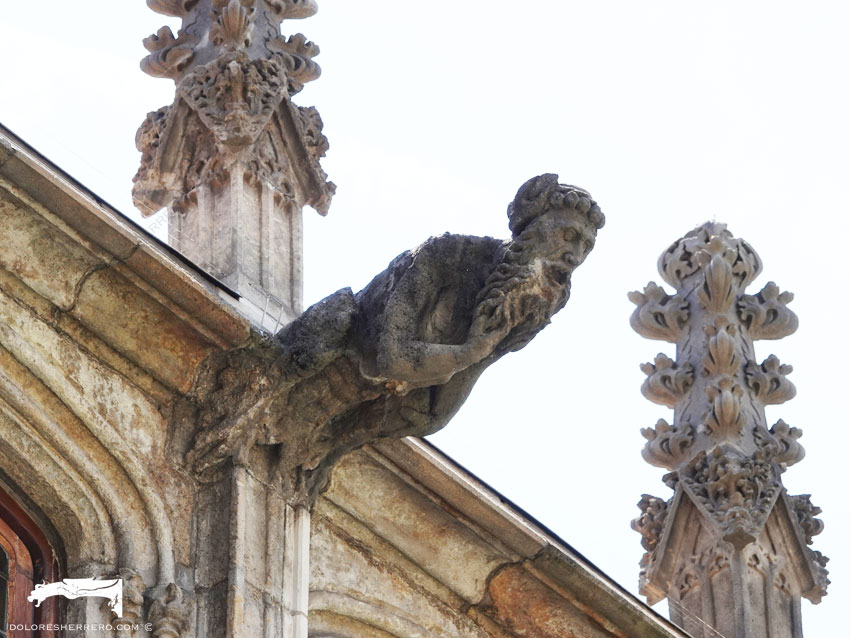
Fig. 20
- Fig. 21
- Fig. 22. Plasencia Cathedral (Spain)
- Fig. 23. Plasencia Cathedral (Spain)
- Fig. 24
- Fig. 25
- Fig. 26
- Fig. 27
- Fig. 28. Batalha Monastery (Portugal)
- Fig. 29
- Fig. 30
- Fig. 31
- Fig. 32
- Fig. 33. Batalha Monastery (Portugal)

Fig. 34
Animal monster
The animal monster, a hybrid formed by combining various animal parts, is commonly represented in gargoyles and grotesques. The first ones we show you are winged quadrupeds, the most commonly represented animal monster: one with a dog’s head and a dragon’s neck (Fig. 35); another with full eyes and curly fur on its head and neck (Fig. 36); the next one with a huge mouth with pointed teeth and a tilted head, with pupils, tail and plume (Fig. 37); another with a monstrous head with pupils, a frontal crest, teeth and a protruding tongue, with a small creature underneath (possibly its young) (Fig. 38); a different one with a large curl on its neck (Fig. 39); we continue with two winged dogs, one with fangs and fur in the form of a fringe (Fig. 40), and another sitting and holding a shield or parchment with its front legs, in an anthropomorphic posture (Fig. 41); a winged bovid with talons instead of hooves (Fig. 42); and the last one with its head facing upwards and a large leaf on its chest reminiscent of one of the gargoyles at Astorga Cathedral (Figs. 43 and 44). Among the following hybrids, there is a winged dog with hind legs ending in a spiral and no front legs, and with a dragon-like belly (Fig. 45). Another winged animal also looks upwards, with its hind legs ending in a spiral, no front legs and a marked trachea (Fig. 46). We also see a quadruped with cloth covering part of its body, a garment that we sometimes see (Batalha Monastery), and a lobed forehead (Figs. 47 and 48). The last two are very original and unusual: the first has the head of a monkey, a plume, it is winged and with no front legs, with a large leaf on its chest and underneath a mixture of decorations that could be a tail, a snake or leaves (Fig. 49); and the second is a hybrid (fish and reptile) with legs and a prominent horn on its head (Fig. 50).
- Fig. 35
- Fig. 36
- Fig. 37
- Fig. 38
- Fig. 39
- Fig. 40
- Fig. 41
- Fig. 42
- Fig. 43
- Fig. 44. Astorga Cathedral (Spain)
- Fig. 45
- Fig. 46
- Fig. 47
- Fig. 48. Batalha Monastery (Portugal)
- Fig. 49
- Fig. 50
Apart from the architectural beauty of the building and its fascinating history, we would never have imagined that we would discover a collection and repertoire of figures like this. The fascination they provoke is inevitable. They are all extraordinary and striking, both in their carving and subject matter. Their expressive power, plasticity, and sculptural excellence, along with the magnificent carving and imagination of the artists who sculpted these wonders, are impressive and moving. When you enter the palace’s courtyards and see all these figures, it is like being in the middle of a total and absolute iconographic overflow. It goes without saying that it is not only the gargoyles that are worth contemplating; the whole building is beautiful and well worth a visit if you go to Barcelona, a city that never disappoints because there is always something new to discover.
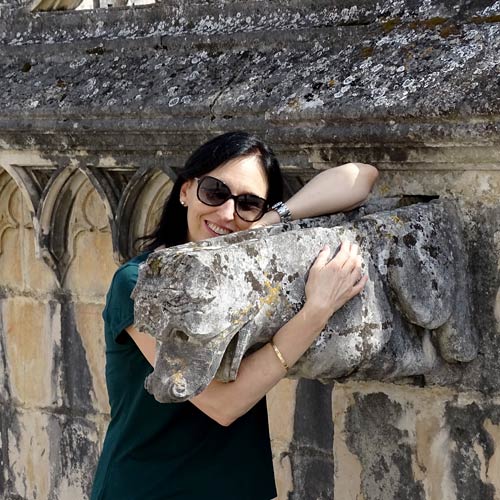
Doctor of Art History and researcher specializing in the study of gargoyles.
I am Dolores Herrero Ferrio, and my thesis, “An Approach to the Study of Gargoyles of Gothic Cathedrals in Castilla and León”, is dedicated to the study of these fascinating figures.
If you like gargoyles and art history, you will also enjoy my book, “The Gargoyle and Its Iconography,” a book I have written with great care for those interested in the world of gargoyles.
I have created my own Encyclopedia of Gargoyles, a Gargopedia to share with you, where you will discover all the secrets and wonders of these enigmatic sculptures.
I hope you enjoy this Gargopedia as much as I have enjoyed creating it, and remember that each gargoyle has a story to tell, and here you will discover them all.
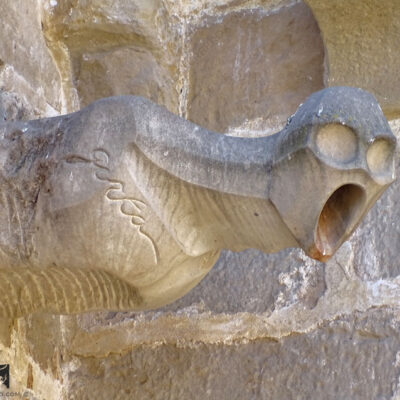 Gargoyles of the Church of Santa María la Mayor in Valderrobres (Teruel, Spain)
Gargoyles of the Church of Santa María la Mayor in Valderrobres (Teruel, Spain)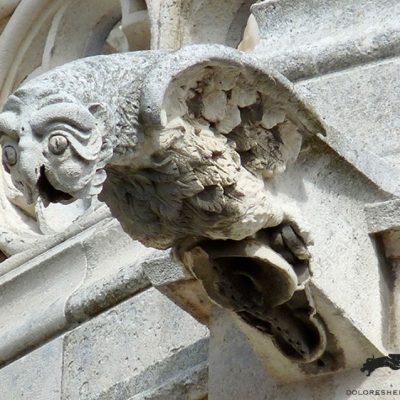 Gargoyles and Unusual Animals: Part One
Gargoyles and Unusual Animals: Part One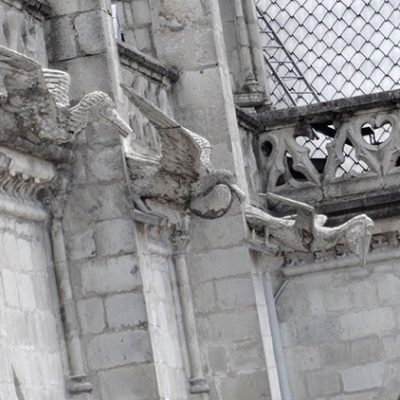 Gargoyles of Quito (Ecuador): Animal Sculptures in Andean Architecture
Gargoyles of Quito (Ecuador): Animal Sculptures in Andean Architecture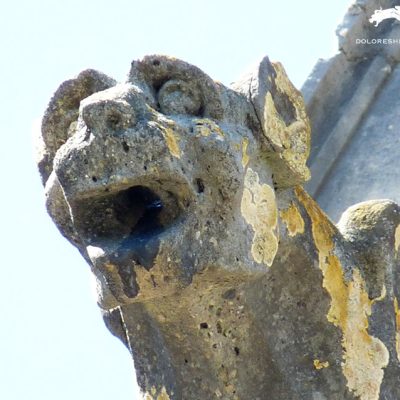 Gargoyles in Limoux (France): The Sculptural Ensemble of the Church of Saint-Martin
Gargoyles in Limoux (France): The Sculptural Ensemble of the Church of Saint-Martin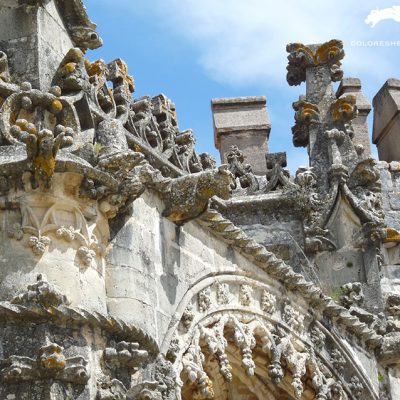 Gargoyles of Tomar in Portugal: Gothic Art and Templar Legacy
Gargoyles of Tomar in Portugal: Gothic Art and Templar Legacy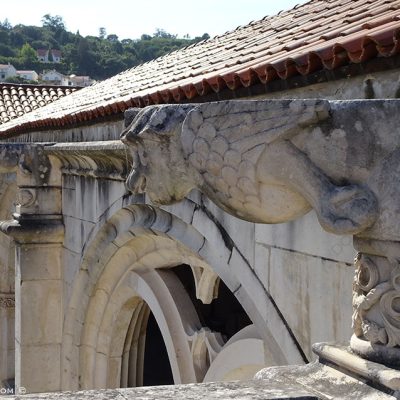 The Gargoyles of the Monastery of Alcobaça: Stone Art in Portugal
The Gargoyles of the Monastery of Alcobaça: Stone Art in Portugal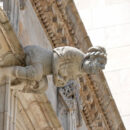 Las ‘gárgolas quimeras’ del Patio de los Naranjos: Criaturas fantásticas en el Palau de la Generalitat de Barcelona
Las ‘gárgolas quimeras’ del Patio de los Naranjos: Criaturas fantásticas en el Palau de la Generalitat de Barcelona Las gárgolas del Monasterio de Alcobaça: Arte en piedra en Portugal
Las gárgolas del Monasterio de Alcobaça: Arte en piedra en Portugal Gárgolas de la Iglesia de Santa María la Mayor de Valderrobres (Teruel)
Gárgolas de la Iglesia de Santa María la Mayor de Valderrobres (Teruel)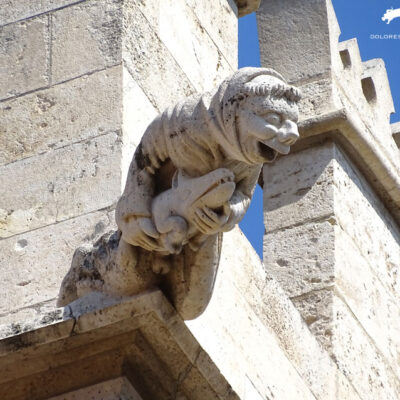 Gargoyles and their Small Companions
Gargoyles and their Small Companions